Italy Diary - June 1999

NOTE: Since this was Kathi's and my first trip together to Italy, we decided to take a comprehensive tour as part of a group. After a good deal of research, we chose the 13 day Globus Italian Mosaic Tour (which is still available from Globus). We thought that this tour would not only give us the best value for our money but that it would also give us a good introduction to many different regions of Italy.
Beginning in Rome, our itinerary would next take us northward into Tuscany: through Milan and into the northwestern region (known as the Lake District); across the border for a brief foray into Switzerland; then back into Italy and heading east to Venice; due south to Assisi, forever associated with St. Francis; on to the Amalfi coast, using Sorrento as our base; and then returning us to Rome for the flight home. To that itinerary we added a 5 day extension in Sorrento (to explore the Amalfi Coast), followed by a 3 day extension in Rome.
Twenty years later looking back on this trip, we feel strongly that the Globus Tour was good value for our money and an excellent way to introduce Italy to first time visitors. We would recommend it.

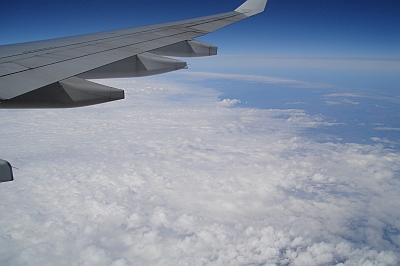
Day 1 - Monday, June 21, 1999 - Home to Rome:
Around 9:30 AM, we left home to drive to the Raleigh Airport for our 3 PM flight to New York City - the first leg of our 12 day Globus Italian Mosaic Tour with two extensions.
Around 3:45 PM, our flight leaves (around 40 minutes late) for JFK airport in New York City - flying time "one hour and fifteen minutes." Arriving at 4:40 PM at JFK, we walk from one end of Delta's terminal to the other, finally finding gate 25 where our flight to Rome is scheduled to leave at 8:30 PM. I have with me a friend's Steadicam Jr. which I have rented for a month. I wanted to take steadier home movies while in Italy for the next 3 weeks. It will prove to be a wise addition to my videotaping (and will ultimately change Kathi's and my life). While waiting for 8:30 PM to arrive, we read our guidebooks preparing ourselves for Rome and Italy. At 7:40 PM passengers start boarding the plane. We get on rather quickly since they start boarding from the front of the plane.
Once on the plane, Kathi and I settle in with copies of the New York Times and of Il Tempo, an Italian newspaper. The plane taxis out at 8:15 PM and at 8:25 our plane takes off; "We're going to Italy!" Our pilot announces that our flight time is seven hours twenty six minutes to Rome and he predicts our arrival to be 30 minutes early. At 9:00 PM the flight attendants start serving dinner. At 10:45, we're finished with dinner and the movie, "Shakespeare in Love," begins.
The overhead TV monitors state that our ground speed is 563 miles per hour (we eventually reach 597 mph), our altitude 35,000 feet, and our estimated arrival time is 10:01 AM. Before falling asleep, we take our sleeping pills for the long night ahead and I read my 40+ pages of experiences, warnings, etc., which I have downloaded from a travel web page. It is full of horror stories of gypsies, pickpockets and tourist traps in Italy. I must be on guard and prepared. I study and then highlight for Kathi some of the most typical practices to be on watch for. She never gets time to read my selections.
One of the most notorious tourist traps I discover is the infamous "Bus 64" in Rome and its legendary pickpockets. It is known to locals as the "Pickpocket Express." Little did I know at the time, but I would encounter both Bus 64 and one of its illustrious pickpockets before our tour of Italy ended! Excited but sleepy, I put my notes away and attempt to get some sleep. I have my sleep mask on and it works well, and I eventually fall asleep for a short period of time in the cramped seats. I wake up long enough to see that our flight plan will take us almost directly over Paris.

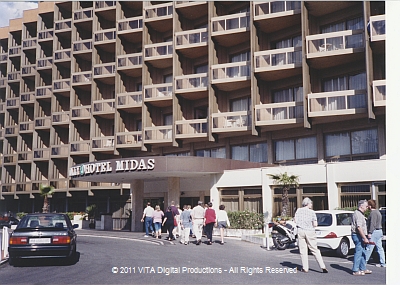
Day 2 - Tuesday, June 22, 1999 - Rome:
It is 8:38 AM Rome time (2:38 AM Eastern Daylight Savings Time) and breakfast ( a croissant with butter and apple cinnamon jelly, fresh fruit, coffee and orange juice) is being served on the plane while I watch news on the overhead TV. We are put into a holding pattern around the Rome airport and therefore lose most of the 30 minutes early arrival we were scheduled to get. Arriving at Fiumicino Airport at 10:25 AM, we deplane and go through the usual security and immigration checkpoints. We look for and find the Globus representative and are told to wait in an area with other Globus passengers. Around 12:45 PM we get on our tour bus which takes us about 20 miles to our hotel on the outskirts of Rome, the Jolly Midas on Via Aurellia.
At 1:35 PM we check into room 748; it's very nice with a balcony overlooking the Via Aurellia. Kathi and I walk around the hotel which has jasmine and bougainvillea in flower; it's 70 degrees, the wind is blowing gently, and it's perfect. We then walk down the hill to the grocery/department store called "Panorama" which is located a short distance below the hotel. The combination grocery and clothing store has lots of fresh fish, fresh meat, a pizza stand, lots of carry out desserts and a large selection of fruits and vegetables. There we purchase hot pizza for two (2,500 Lire) and use our Italian for the first time.
Since Kathi and I have booked a 5 day trip extension in Sorrento at the end of the 12 day tour, followed by a 3 day extension in Rome, we took a Conversational Italian course at the local community college.
At 2:37 PM we're back in our room. The Via Aurellia below is a busy 4 lane expressway. In the distance we can see the top of St. Peter's Basilica. At 4:30 PM our group gets on the tour bus for an orientation meeting with our tour guide who tells us about procedures, what to expect, etc. Afterward we meet and talk with a couple from California, Karen and Frank, who will also be staying in Sorrento with us at the end of the tour.
I, of course, have to sample Italian television and it is quite a change. There are two channels in English: CNN International from the US and SKY TV from Great Britain; the remaining channels are mostly Italian with a few German and French ones. Later I would discover that topless ladies are not unusual late at night on Italian TV.
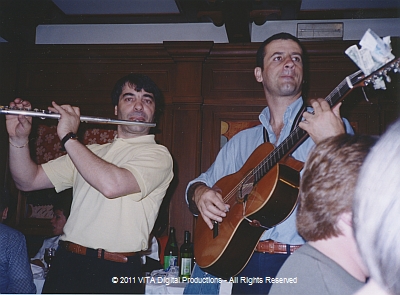
At 6:35 PM, we go downstairs to leave for our "Welcome to Italy" dinner. Our tour guide, Vincenzo, is an older man who has obviously led these tours for many years. After we file onto our motor coach and meet our driver, Pierro, we wait 5 or 10 minutes for an older couple (later to become our friends) to arrive. Our tour guide tells them in a surprisingly stern way that tardiness will not be tolerated. As the tour progresses we come to respect and appreciate Vincenzo's strict schedule - it helps us to arrive first at many of the busy tourist sights, ahead of the other tour buses.
We then leave for the drive through Rome to our restaurant for the "Welcome to Rome" dinner, and I get my first look at Rome. There are scaffolds covering the fronts of public buildings everywhere. We learn that work is being done all over Italy for the Pope's Jubilee celebration to be held in conjunction with the millennium.
Arriving at our destination, we exit the bus and walk about three blocks through a mixed residential and business district in the city. Finally we get to our restaurant, the Mangrovia, and our group goes upstairs and into a private dining room. Kathi and I are seated across from a nice family of four from Connecticut.
Our waiter serves us wine and our antipasto, cantaloupe wrapped with proscuitto ham. Three other courses follow and they are delicious. Finally dessert and coffee are served.
All during our meal two male singers serenade us with Italian songs. While Kathi is busy talking to Tony, I lean over and ask them to sing "Al di La," a song from the film "Rome Adventure" which we had just watched before leaving for Italy.
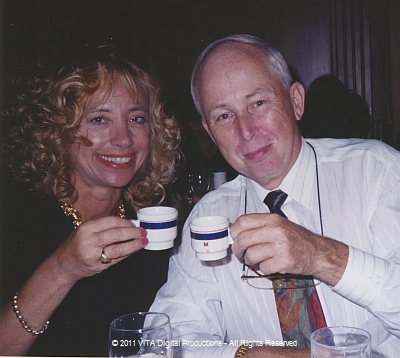
At the end of the evening, the waiters bring a single long-stemmed yellow rose for each of the ladies in our group. Kathi describes the evening as "molto bene." We walk back to our tour bus with the beginnings of newly-formed friendships and drive through a brightly lit Rome, returning to our hotel around 10 PM. What a memorable day.

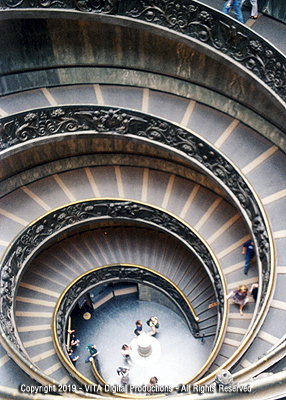
Day 3 - Wednesday, June 23, 1999 - Rome:
Up at 6:30 for an early breakfast in the hotel's dining room: croissants, danishes, butter, jellies, orange juice, coffee, hard rolls, sliced boiled ham - it's quite delicious. Then down to our tour bus for our drive into Rome. It's 7:28 AM; Kathi and I are the first ones on the bus so we naturally pick the front seat directly behind the driver. Our drive into the center of the city introduces us to Rome at rush hour. Traffic is hectic with Vespas (Italy's little motor scooters) darting past the tour bus on both sides and, at stoplights, squeezing into every available nook and cranny. Undaunted, our driver, Pierro, expertly maneuvers our massive tour bus through the heavy traffic and small streets.
Exiting the bus we meet our Rome tour guide, Manlio. He will guide us through the Vatican Museum and later in the day, the Roman Forum and Coliseum. We walk four blocks to the entrance of the Vatican Museums, arriving about 8:30 AM.
Manlio gives us our tickets and we enter the building and walk up an amazing double spiral ramp and out into a courtyard where he gives a talk about the Museums, their treasures and the famous Sistine Chapel. While he does this, I videotape and take photos of the courtyard.
I have read in one of my tour books that in the summer, the Pope usually gives an audience around 11 AM on Wednesdays. I imagine what a wonderful opportunity it would be to actually see the Pope. During the morning our new friends, Harold and Margaret from Louisiana, mention to us that they want to attend the Pope's address this morning, too. Harold tells us that they've asked around and everyone they've talked with has given them a different time for the Pope's address; some say 11 AM, some say 10:30, some even say as early as 9 AM. And, there is a good possibility that his address will be canceled if he is not feeling well. (He has just returned from a trip to Poland where, due to poor health, he canceled a mass with several million people waiting.)
If we four are going to try to attend the audience, we'll have to leave the Vatican Museum tour early and walk almost a mile to St. Peter's Square. Should we attempt it when we don't have any assurance that the Pope will even be there? And if he is there, what time will it start?
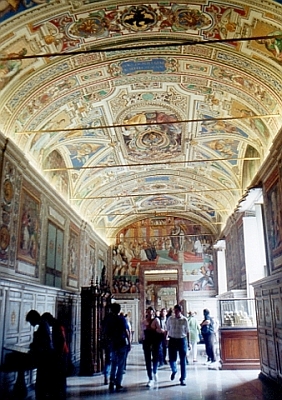
Kathi doesn't want to leave the tour, as there are wonderful things to see and she could easily spend several days in the Vatican Museums and not see it all. But I tell Kathi that this is a chance in a lifetime: a chance to see the Pope. I explain to her that when the Pope comes to Mexico, or Poland, millions of people come from far and near to see him. And some of those people are so far back in the crowd that they don't actually get to see him. In addition, I mention that he's old and infirm and this will certainly be our only chance to see John Paul II. Finally I convince her, and we leave the tour around 9:37 AM. With Harold in the lead, we hurriedly walk (almost run) through the halls of the Museum to find an exit.
The Museum is designed so that there is only one pathway through it and there are no shortcuts out to the street. So we must go through endless corridors - all with wonderful statues that beg to be viewed at leisure - but no time for that! Every time we turn a corner and enter a new corridor, Kathi's doubts as to whether we're making the correct choice return to her and she hesitates. But I try to reassure her, telling her that she and I will have another chance to visit these museums when we return to Rome on the extension at the end of our trip.
While I promise her that we will return, I realize that if the Pope doesn't show up, I have made a serious mistake. I certainly hope I'm right. The four of us finally arrive in the Sistine Chapel and we pause for 3 minutes to stare up at the magnificent ceiling by Michelangelo. Then, we're out into the street wondering how to get to St. Peter's Square.
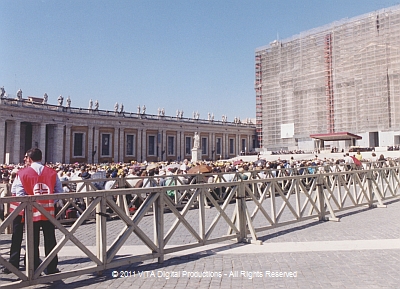
We decide to follow the Vatican wall and hope that it will eventually lead us to St. Peter's Square. Walking quickly, almost running, we pass vendors selling miniature "Pietas," sweatshirts, umbrellas, postcards, etc. After about 15 minutes we arrive at the entrance to St. Peter's Square just in time to hear the last few bars of "Pomp and Circumstance" followed by a voice over the public address system introducing the Pope in various languages. We've made it in time to hear the Pope's address!
And there, under the large red papal canopy, we can just make out the figure of a man in white robes seated - Pope John Paul II himself. After the greetings and introductions are finished, the microphone stand is moved in front of the Pope and we can hear him inhale and he begins to speak - in Italian, of course. He speaks for 20 minutes and although we know very little Italian, Kathi and I are pleased to discover that we can understand some of what he is saying.
What a wonderful and memorable experience… I remove my wide angle lens attachment from my camcorder so that I can zoom in on the Pope as much as possible. Kathi and I are deeply moved listening to the Pope's words and we can actually see him too.
At around 10:20, after the Pope completes his address, we leave St. Peter's Square and hurriedly walk back to the entrance to the Vatican Museums and rejoin our tour group as they leave around 10:40 AM.
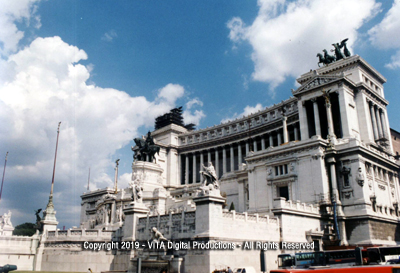
Back on our tour bus and as Manlio talks, our driver takes us through the heart of Rome, past the Victor Emmanuel Monument which holds special meaning for Kathi, past the balcony where Mussolini made his addresses to the Italian people during World War II, and on to the Roman Forum and Coliseum. At the Roman Forum, we walk along the Via Sacra and I videotape and take photographs while Manlio talks to the tour group.
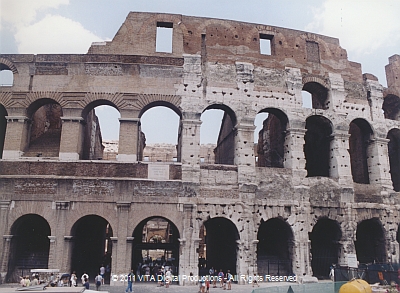
Next, around 11:55 AM, we walk to the Coliseum where again I photograph and videotape. While here Kathi purchases two gelatos from a small stand (Kathi, chocolate, and me, vanilla) for 10,000 Lire and afterwards is convinced that she had been overcharged (but later decides that she had not). I purchase a watercolor print from a street vendor for 5,000 Lire and some postcards for 1,000 Lire. We stop to pet some cats that inhabit the Coliseum before seeing more of Rome.
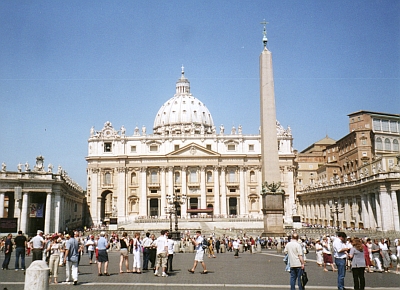
At 1:03 PM, we get off the bus to enter St. Peter's Basilica, the largest church in the world. After leaving the Basilica, we stop to let Manlio off and most of us give him tips for his excellent work. We then return to our hotel for the remainder of the afternoon.
At 3:15 PM, Kathi and I again walk down to the supermarket at the bottom of the hill below the hotel where we purchase four 1.5 liter cokes, a 1.5 liter bottle of water, and a box of Ritz crackers which we take back to our room (I have brought with me from the US a small jar of peanut butter - believing that it would be impossible to find it in Italy). The selection of foods is certainly different than those found in the US. There are some fruits and vegetables that I am unable to identify. Returning to our hotel room, I watch Italian TV while Kathi writes a few postcards to friends and attempts to catch up on her journal.
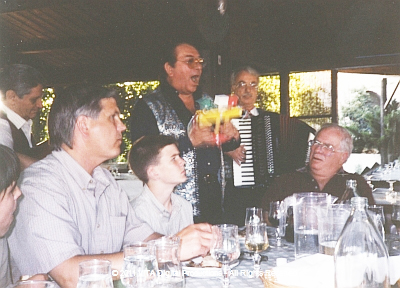
Around 4:25 PM, dressed for dinner, we leave on the tour bus for our trip to Castel Gondolpho (where the Pope has his summer residence) and then on to our quaint country restaurant for dinner. We first pass through Rome, then the outskirts of the city, and finally out into the countryside, at one point traveling on a portion of the famous Appian Way. Vincenzo has promised that this dinner will be memorable both for its setting and its food - and afterwards, I have to agree with him. Our group is seated outside at two long tables under a grape arbor and our dinner begins with antipasto, followed by delicious fresh pasta, and a main course, followed by insalata mista, and dessert and coffee.
All throughout our meal, several musicians and a singer entertain us and I, of course, request the song, "Al di La," for Kathi. Later, our new friends from California have an opportunity to visit the kitchen to see how the tomato sauce for the pasta was prepared. Then the four of us take a walk in the vineyards at sunset (which comes quite late on a summer night in Italy) - a magical evening. Before leaving the restaurant, I purchase a copy of the singer's CD. Around 10:30 PM, we arrive back at our hotel.

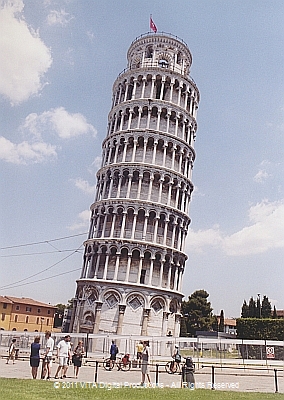
Day 4 - Thursday, June 24, 1999 - Rome to Florence:
Up early and to breakfast in the hotel dining room. Because we are leaving Rome today and traveling to Florence, our bags have to be packed and outside our room by 7:00 AM. Around 7:30, our tour bus leaves Rome for our drive north. Following the coastal highway, we drive by the city of Civitavecchia. To our left across the water, we can see the island of Elba, where Napoleon was exiled and almost certainly poisoned. After stopping at an "AutoGrill" (a chain of poorly organized cafeterias which we would learn to hate) for coffee, our tour bus eventually arrives in Pisa where we make a short stop.
Pisa and its Leaning Tower are a disappointment for both Kathi and me. Surrounded by souvenir stalls and hundreds of tourists, they are too commercialized and lack the quiet dignity I feel they deserve. The only pleasant part about our visit to Pisa is that Kathi encounters two friends who had been with her on her trip to Greece three years earlier and a few weeks before she and I met. Kathi introduces me to them and I take Kathi's picture with them. Kathi and I have a gelato before leaving Pisa. We get back on our tour bus for the drive to Florence.
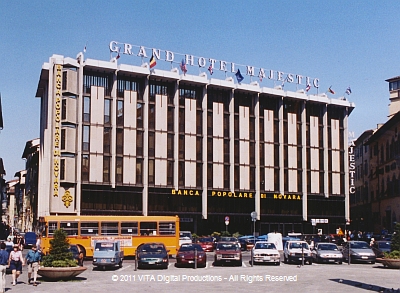
After a short ride, we arrive in Florence and find our hotel. The Majestic on the Via Del Melarancio is wonderful, not only because of its elegance and marbled bathroom, but its location; within walking distance of everything we will wish to see in Florence. As soon as we can check in, we find our room and leave the hotel for a walking tour of Florence.
Walking a few blocks, Kathi and I suddenly find ourselves in front of the famous Cathedral of Florence or Duomo, the Santa Maria Del Fiore, and Giotto's Bell Tower along with the eight-sided Baptistry with its famous bronze doors - the "Gates of Paradise" by Ghiberti. As we stand there, in awe of the scene before us, the bell from Giotto's Tower chimes 5:00 PM.
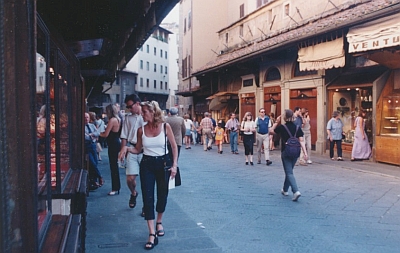
Many of the city streets are closed to traffic and filled with pedestrians. As we stroll we pass hawkers selling their wares spread out on cloths on the bare pavement, we turn and see a polizia car driving toward us on the closed off street, pedestrians parting before it. The hawkers quickly gather up their wares, grabbing the cloths by the corners and walking quickly away, acting nonchalant as the polizia drive by. The polizia obviously know what's going on -- it's all just a game with both groups. The hawkers pretend that they are not selling when the police drive by and the police pretend they don't know that there are hawkers selling illegally. Moreover, during the coming weeks in Italy, we realize the laws in Italy are merely "suggestions." Stop signs (which actually say "STOP" oddly enough - even in Italian) are also merely suggestions and most drivers ignore them. And the white lines delineating lanes in the streets are completely useless -- no one follows them. The cars, as often as not, drive so that they actually straddle the white lines.
Italian drivers, we are surprised to discover, are fearless but amazingly precise -- in all of our twenty-two days in Italy, we see only one accident and that one is here in Florence. But we regularly watch in awe (and a little terror) as Italian drivers navigate madly between cars and buses with only inches to spare and then stop abruptly only inches away from another car or bus. And the motorcyclists and Vespa drivers are even more daring, if that can be imagined, weaving in, out and between lanes of traffic, at stoplights filling in every empty space available on the pavement (and sometimes even the sidewalks).
Of course, all this frenzied driving does lead to disputes, and we sometimes watch from our tour bus as drivers argue, arms flapping in the air, about some disagreement over their driving. Italians can't seem to talk without using their hands and arms as punctuation devices. Continuing our afternoon walk in the streets of Florence, Kathi lags behind, first window shopping and later, entering a shop which has large "Going Out of Business" signs posted. I continue on, taking the Steadicam down the street, videotaping as I go.

At the end of the street, I turn a corner and enter the expansive and beautiful "Piazza della Signoria," filled with massive statues and onlookers. I turn around quickly and return to get Kathi, excited to show her my discovery. As I arrive at the shop, Kathi is coming out the door and I quickly ask her to follow me, stating only that I have something to show her. As we walk back to the Piazza, with Kathi a few steps behind, I turn the video camera backwards toward her, wanting to get her reaction when she first sees the wonderful Piazza and its statuary. And I'm not disappointed. She is amazed as she enters the Piazza for the first time, stopping at each of the large modern statues on display. She likes one more than the others, El Gato, a large, fat cat.
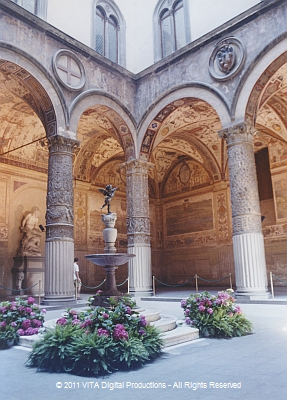
At the other end of the Piazza, we see the Palazzo Vecchio with the copy of Michelangelo's David outside. Walking across the Piazza, Kathi and I enter the Palazzo Vecchio and are pleasantly surprised at the beautiful ceilings and sculptures which we find inside.
Twenty minutes later, as we leave the Palazzo Vecchio I discover a Dutch television camera crew outside filming and using a large professional model of the Steadicam. As the cameraman is hooking up the Steadicam to his steel and leather chest harness, I go over and point out to Kathi the word, "Steadicam" on his chest and, in turn, show him the same word on my little Steadicam, Junior. He smiles acknowledgment - we're brothers, linked by our unique equipment.
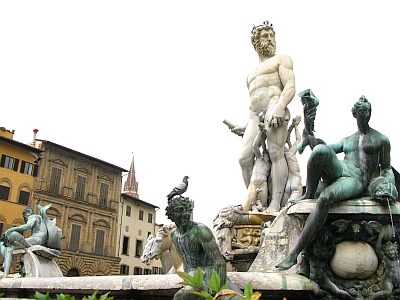
He and an assistant climb over a railing and begin to shoot video of the famous Fountains of Neptune outside of the Palazzo Vecchio. As he and his assistant walk to get a moving shot of the fountains, I follow him but outside of the railing. I'm shooting him shooting the fountains. We both do this a couple of times until the polizia arrive and stop him.
As near as I can determine, the polizia are telling him that he does not have the proper permits which would allow him to cross over the railing around the fountain. He climbs back over the rail and continues shooting but this time, well outside of the forbidden area. We are surprised to see demonstrated how meticulously Italian polizi enforce some regulations and yet ignore many of the others. Kathi and I leave the piazza and walk back to our hotel in order to get ready for supper.
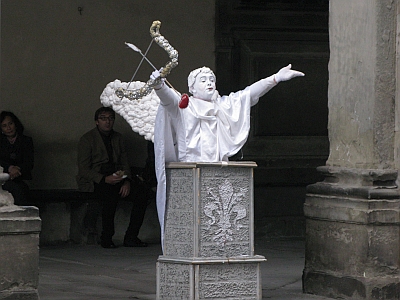
Dinner tonight is in the hotel's dining room. We join Lanie, Peter, Elayne, and Gloria at their table and get to know more about our new friends. Elayne tells us about her unique part-time job, giving educational talks on cruises. She gives one or two one hour lectures on the historical and cultural significance of an upcoming port and, in return, gets to enjoy the entire cruise for free.
After dinner, Kathi and I return to the streets of Florence, wandering through the wonderful maze of avenues and alleyways, all crowded with thousands of strollers like us. We chance upon Karen and Frank while watching two street performers and converse with them for a while. Later, while walking in another little street, Kathi and I hear the sound of fireworks in the distance. Walking quickly in the direction of the explosions, we finally arrive at the river Arno in time to view some of the pyrotechnic display. Afterwards, as we are walking back to the hotel, I am still filming with the Steadicam. From across the street, I hear a young man call out in an Italian accent, "Steady?" to which I respond, "Yes."

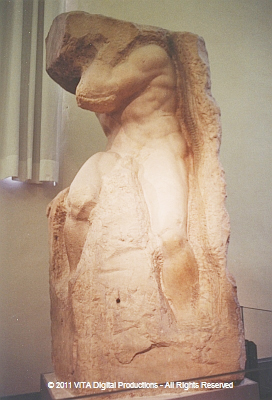
Day 5 - Friday, June 25, 1999 - Florence:
Breakfast at 7:00 AM in the hotel dining room. Then we leave for our drive to the Galleria dell' Accademia and one of the highlights of our trip, experiencing Michelangelo's magnificent "David." Leaving our tour bus, we meet our guide, Leah, and we all walk the four or five blocks to the Galleria dell' Accademia.
Our guide books state that there is frequently a wait of several hours to see "The David" as the statue is more commonly known, but, at 8:30 AM, we walk right in - another case where Vincenzo's vigilance in keeping us to a tight schedule pays off. We enter a small hallway, turn right and there he is, at the end of a long corridor. Along both sides of the corridor are displayed Michelangelo's "The Prisoners," unfinished sculptures with figures symbolically struggling to get out of their blocks of marble. They are surprisingly inspiring but again and again we find our attention drawn to the massive sculpture at the end of the corridor, "The David." Our guide is explaining the background of "The Prisoners" but, as usual, I leave the group and begin videotaping on my own.
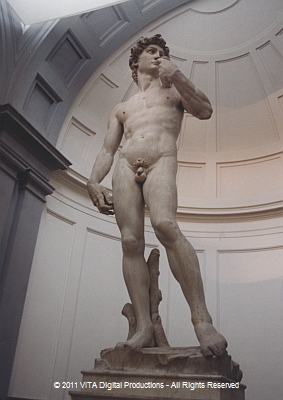
After shooting "The Prisoners," I start photographing "The David." I am amazed by its emotional impact. It is big, but I expected that, -- but what I didn't expect was its perfection. The detail is amazing; well-defined muscles and blood vessels are exactly where they should be, his right hand perfect in its detail. One could easily imagine that Michelangelo just laid down his tools a few minutes ago and that there are still marble chips at its base.
There's no apparent evidence that this sculpture was outside in the Piazza della Signoria, exposed to the elements for over three hundred years before being brought inside to this protected location. Its surface appears smooth and polished as if new. I turn around to discover Kathi standing there, looking up at "The David," with an incredible smile on her face and tears in her eyes, as if mesmerized, attempting to grasp the emotion of this moment.
I find it surprising that photography, both video and still, is permitted in the Galleria dell' Accademia, with the one stipulation of no electronic flash. Warning signs, with the international symbol of the red circle and diagonal bar over a camera with flash, are posted everywhere. Nevertheless, guards constantly have to tell people to stop using the flash on their cameras. During the thirty minutes we were there, a flash went off an average of once every 30 seconds with a guard hurrying over to motion "No" to each offending photographer. I have to assume that most people did not know how to turn off or defeat the electronic flash on their cameras and took the photographs anyway, knowing that nothing but a warning would ensue. But after thirty minutes of almost constant flashes, I was left with the impression that these were rude, uncaring, and stupid people.
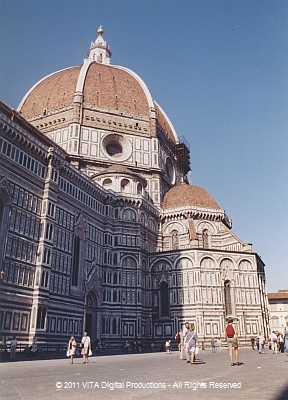
Leaving the Galleria dell' Accademia, we walk several blocks to the famous Duomo.
The Florence Cathedral, formally the Cattedrale di Santa Maria del Fiore, is the cathedral of Florence. It was begun in 1296 in the Gothic style to a design of Arnolfo di Cambio and was completed by 1436, with the incredible dome designed by Filippo Brunelleschi. The exterior of the basilica is faced with polychrome marble panels in various shades of green and pink, bordered by white, and has an elaborate 19th-century Gothic Revival façade.
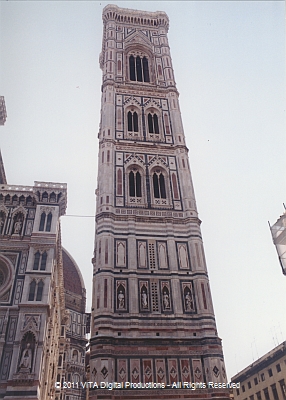
Kathi insists that we are going to climb to the top of Giotto's Campanile (bell tower), even though it's over 300 steps up (and 300 down). We purchase our tickets and start our ascent. At several places while we are still climbing upward, we stop and look out the beautiful stone window openings. About two-thirds of the way up, we come to the bell chamber, a large open area with expansive open windows.
Finally we arrive at the top of the bell tower. The walkway around the tower has stone blocks up to your chest with steel wire, recently installed, covering both the sides and the top, making it impossible for anyone to jump from this height. One has to wonder if someone has, in fact, jumped from the top of this tower before the steel wire was installed? I busily take my video and photos of Florence (which is spread out below me).
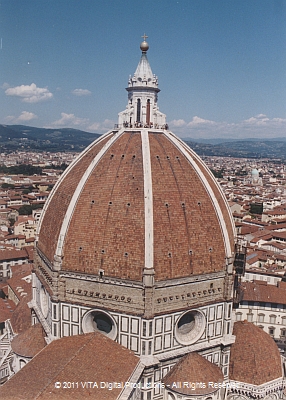
Then I turn my attention to Brunelleschi's dome over the Duomo, of which Michelangelo once said, "I can build a dome bigger, but I can't build one more beautiful." We are on the same level as the top of the dome, right across from us. We can see the large holes which Brunelleschi (the first important architect of the Italian Renaissance) used to hold the scaffolding poles while the dome was being constructed over 500 years ago.
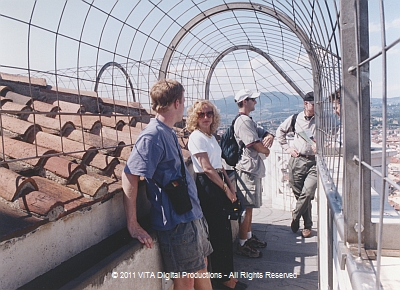
As I continue to photograph this incredible view, Kathi hears what appears to be familiar American accents. She introduces herself and me to the other tourists and is pleased to discover that all 6 of us who are currently at the top of Giotto's Bell Tower in Florence, Italy, either were born or educated in Virginia. What a wonderful coincidence and, as they say, a small world.
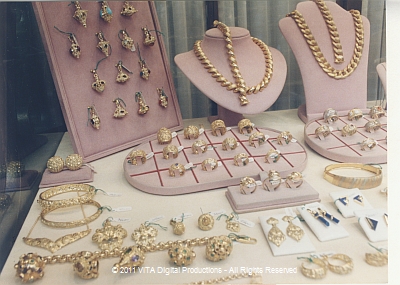
Next, we walk several more blocks to tour a leather factory. But instead of taking the leather factory tour, Kathi and I decide to visit some gold shops in hopes of finding some gold rings for both of us. We ask Vincenzo for a recommendation and he gives us the names of two jewelry stores to check out. The first one was just a block away so Kathi and I walked straight to it.
Once there, Kathi describes to a very nice sales clerk what she is looking for, and the saleslady promptly shows us some lovely rings. Kathi immediately focuses her attention on a unique faceted gold dome ring. She fell in love with the ring for several reasons, one of which is the appropriateness of selecting a domed ring in Florence, a city famous for Brunelleschi's dome over the Duomo. I, in turn, select a beautiful tricolor ring with spiraling bands of rose, white and yellow gold.
But logic and experience tell us not to buy the first thing we see; we must look at other gold shops before making such an important decision. We tell our clerk that, although we are sure we'll return to purchase these two rings, we must visit some other stores before deciding and we leave. We enter the other gold shop which Vincenzo has recommended and quickly conclude that they have nothing as beautiful (or as unique) as the previous shop. Returning, we make our purchases, I pay for Kathi's ring and she pays for mine, and arrange for the rings to be sized and picked up later that afternoon. (Ten years later we will return to the same jewelry shop in Florence to purchase a matching necklace for Kathi.)
We hurry out of the store and run right into Frank and Karen. When we tell them about the store, Kathi wants to return and show them the ring she has selected. Once inside, Frank decides to purchase a gold chain for himself. The four of us return to the leather factory where other members of our group are in the process of leaving. Excitedly, we tell them of our purchases.
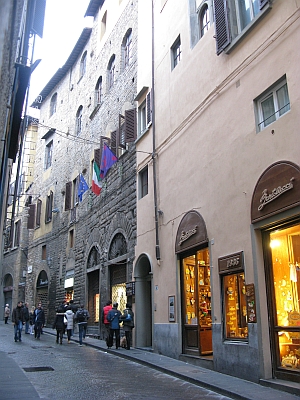
We return to our hotel room for a picnic lunch of sandwiches made from rolls and ham, made at breakfast earlier today - a tip I learned reading "The Great Bicycle Expedition" by William C. Anderson, over 25 years earlier. After finishing our lunch, we return to the streets of Florence. Walking down a little alleyway, Kathi and I enter a quaint looking little shop. It turns out to be a combination hardware and grocery store. While I examine the selection of hardware and gadgets, Kathi looks over the selection of foodstuffs and selects a package of tea for a friend back in the states.
We enter a little shop looking for a print for Kathi's friend, Beth. I discover a large assortment of 360 degree panoramic post cards of the city and select a few of the best ones. Kathi chooses a beautiful print of the Duomo for Beth and a calendar with photographs of the Sistine Chapel for her new office.
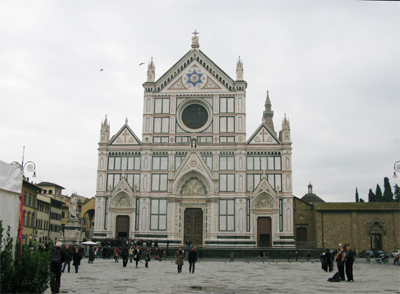
Kathi and I return to the Jewelers to pick up our rings after resizing. They are both perfect. Stuffing them into a safe place in my money belt, we leave the store. Just outside of the jewelers' shop is the Church of Santa Croce which contains the tombs of Michelangelo and Galileo. Kathi and I enter the church for a quick look at the interior.
After leaving the Church, we walk towards the Ponte Vecchio. I consult my map but things aren't as clear as they should be. Eventually, with a little luck, we find ourselves beside the Arno River. From there it is not difficult to find the Ponte Vecchio which crosses the Arno, of course.
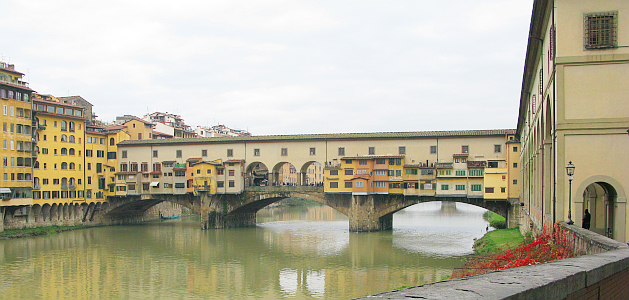
On our walk, Kathi and I enjoy watching some boaters crewing in the river. Arriving at the Ponte Vecchio, we find it crowded with people - it is, after all, one of the most famous tourist sites in all of Florence. Kathi is fascinated with the gold jewelry displayed in the goldsmiths' shops which line both sides of the ancient bridge.
The Ponte Vecchio was the only bridge not destroyed by the Germans during World War II. All of the other bridges were destroyed by dynamite. Today, rebuilt bridges stand where they once stood, but, unlike the Ponte Vecchio, are not the originals. While Kathi window shops, I continue on ahead photographing. When I return and find Kathi, she tells me that she has not found anything as beautiful as her ring which we purchased earlier today.
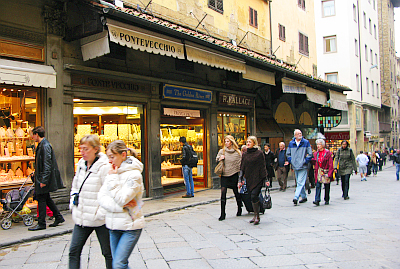
Before leaving the Ponte Vecchio, I fill my water bottle at a fountain in the middle of the bridge. Water is a precious commodity in Italy - one usually has to purchase bottles of water and it doesn't come cheap. In addition, one must be careful of not accidentally getting a bottle of "Gas" - carbonated (ugh!) bottled water which is popular all over Italy. Therefore, I must remember to state "No gas" when requesting bottled water. On our walk back to the hotel, Kathi and I stop at a small restaurant for dinner.
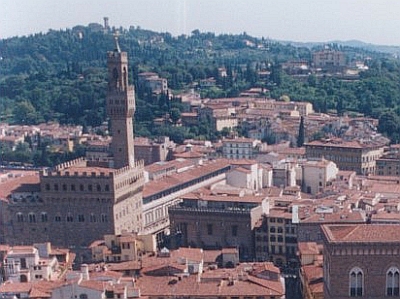
Around 7 PM, Kathi and I visit the Uffizi Palace Art Gallery. We know when we enter the Uffizi that closing time is around 8:00 and that we wouldn't have much time to see this world famous art gallery, but decide to try to see as much as possible in our limited time in Florence. This is another of those attractions where a long line is usual but we walk right in with no waiting.
We walk briskly through the corridors and galleries, stopping from time to time to view a particular sculpture or painting. We see many very famous paintings at the Uffizi. I videotape the entire hour we were there -- in addition to the Steadicam, Junior, another asset which I brought on this trip was the two new nickel-halide batteries for my camcorder. They each last 3 full hours so I never have to worry about running out of battery power, no matter how long I videotape. Leaving the Uffizi, we watch as guests arrive for a fashion show in the courtyard adjacent to the gallery. Italians, dressed to the "nines," enjoy proscuitto ham and other treats, chat and pose for cameras - ah, la Dolce Vita.

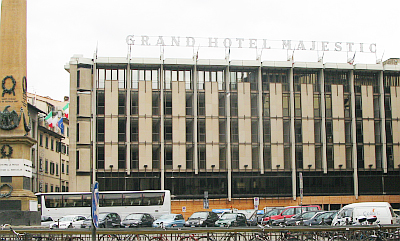
Day 6 - Saturday, June 26 - Florence to Genoa to Milan to Lake Maggiore:
Breakfast in hotel dining room. I make it a habit, whenever possible, to get an extra hard roll, along with some ham, wrap them in a napkin and save it for a snack later in the day.
Getting on our tour bus, it is obvious that none of our group is rotating seats anymore. We had been told that we would rotate seats each day of the tour. The very first full day in Rome, Kathi and I sat in the very front seat immediately behind our driver, Piero. The next day, we moved to the very back seat on the bus (which wasn't a bad seat after all). The third day Kathi and I moved forward one seat and then everyone, for some unknown reason, stopped rotating seats, and we were frozen into the same seats for the rest of the tour. Actually this was not a problem at all, Kathi and I usually had two empty seats either in front of or behind us in which we could stow our backpack, cameras and other bags, and we enjoyed talking with the people seated around us.
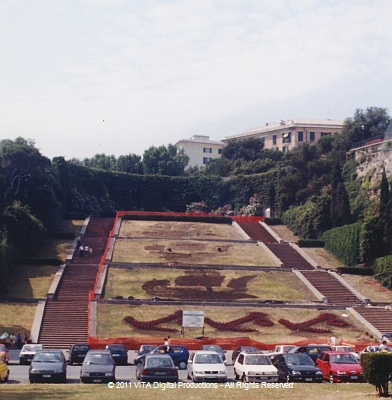
After traveling about 3 hours, we stop in the city of Genoa, birthplace of Christopher Columbus. As soon as we get off the tour bus, gypsies with cardboards approach us. Vincenzo has warned us of this scenario: A group of gypsies approach tourists, surround them, and using cardboards which they wave constantly to both distract and to cover their hands, pick their pockets or purses. In another scenario, a gypsy mother will approach and unexpectantly hand you her baby to hold and, while you are holding the baby, will pick your pocket or purse. As the gypsies approach Peter's wife, Lanie, who is in front of us, she shakes her head "No" but they approach her closer still. Peter finally says, "No" very loudly and they leave her and turn their attention to Kathi and me. We say, "No," shake our heads and walk quickly by them.
We hurry on down the street to have a quick lunch in a McDonalds. After using the restroom, and while we are standing in line to place our order, we meet and talk with a young medical student from Greece. Before we can place our orders, the gypsies enter McDonalds and place their cardboards on chairs and leave to visit the restroom. One of our group members says he's going to steal the gypsies' cardboards and we all have a good laugh over this proposal. The gypsies return and get in line with us. Vincenzo comes over to warn us again to be on guard. We heed his advice and nothing happens. After eating, Kathi and I cross the wide boulevard to do some shopping. I go into a bookstore while Kathi window shops. A few minutes later we walk up to the street corner and I take some photographs of Kathi and the intricate mosaics on the sidewalks. Back on the tour bus for a two hour drive to Milan.
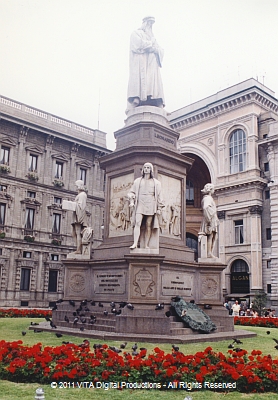
Once in Milan we exit the bus and walk to a city square which has a large statue of Copernicus surrounded by flowers.

Crossing the square, we enter the famous Galleria, a covered shopping street, built in the late 1800's. Kathi and I separate and I go into a bookstore while Kathi goes shopping. Later, Kathi and I leave the Galleria and enter the Milan Duomo, the second largest cathedral in the world, which, of course, is under renovation for the Pope's Jubilee Celebration. As our group returns to our tour bus, we notice that the famous La Scala Opera house is also under renovation. I also see a TV production truck parked outside of La Scala in preparation for televising some production from the opera house.
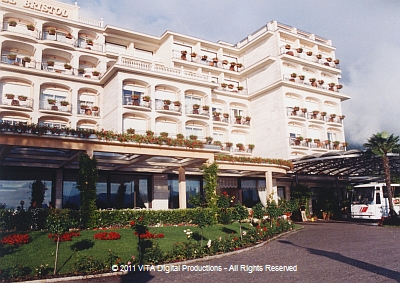
Back on our tour bus for an hour's drive to Lake Maggiore and the vacation resort of Stresa. Our hotel, the Hotel Bristol, is exquisite. Our room has French Provincial furnishings along with a small crystal chandelier and an enchanting view of Lake Maggiore from its balcony. After unpacking, Kathi and I walk into the little town of Stresa. It is incredibly picturesque. After some exploring, we return to our hotel and enjoy a marvelous dinner with our tour group in the hotel dining room.

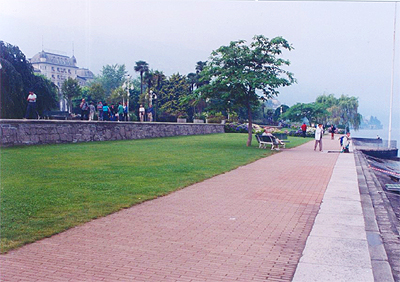
Day 7 - Sunday, June 27, 1999 - Stresa and Lake Maggiore:
Breakfast in the hotel dining room and a restful day lies ahead for us. Kathi and I take a leisurely walk along the lakeside and go back into the little resort town of Stresa. Then, as usual, we separate, Kathi shops while I photograph.
Later we find each other and have lunch with Andy and his family at an outdoor café. Fortunately we are dining under an awning because before our lunch is over, it begins to rain. Leaving the restaurant, I purchase a much needed umbrella and Kathi and I leisurely walk back to the hotel in the rain. Once in the hotel Tony's son, Justin, tells us that we must see the "elevator," and he takes us to it.
We get in, press the button, and….. It runs sideways - what a surprise! Later, we have another memorable meal in the hotel's dining room. Afterwards, our friends Harold and Margaret join us for a walk outside and, as light rain begins to fall again, we duck into the Hotel Regina's lobby to get dry. An enjoyable and restful day.

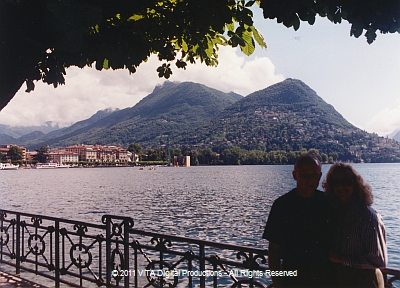
Day 8 - Monday, June 28, 1999 - Lake Maggiore to Lugano, Switzerland, Verona, and to Venice:
Breakfast in the hotel dining room. A lovely drive along the edge of Lake Maggiore into the Italian-speaking part of Switzerland. Then into the "Pre-Alps" with its winding road and beautiful vistas. We go through several long tunnels - - one three miles long. Vincenzo warns us that when we stop at the Swiss border, no photography is permitted and that it is possible that the border guards will check each person's passport. When the bus stops at the border, we are all unusually quiet and on our best behavior and are passed through without incident.
A few minutes later we stop in Lugano, Switzerland. Exiting the tour bus, we first enter a jewelry store to pick up the free silver spoons given to all Globus tour groups. Kathi and I window shop along the elegant Via Nassa, then go into a department store and purchase some Swiss chocolate bars. We are surprised when we pay for our purchases in Italian Lire but get our change back in Swiss Francs. What can we do with Swiss Francs in Italy - - they won't be accepted there. So, we go back in the department store and try to spend the rest of our Francs by purchasing more candy bars. Days later, Kathi would notice that most of the chocolate bars we had purchased contained alcohol in one form or other and tasted awful! We ended up leaving the expensive chocolate bars as gifts for our maids.
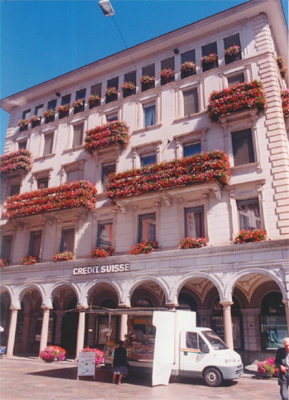
Leaving the department store, Kathi and I walk into the large open square, Piazza Riforma, with its lovely flower and vegetable stalls. We stop and talk briefly with Peter and Lanie sitting at an open air café, then join Karen and Frank before returning to our tour bus.
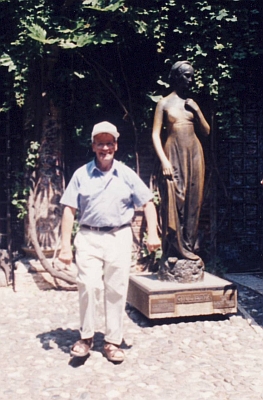
Next, a four hour trip through the Po River Valley to the city of Verona. It should be noted that our tour guide Vincenzo uses the time in transit wisely, as an opportunity to talk about the history of sites we will visit and background on the Italian culture.
Once in Verona, we walk to Juliet's Balcony with its (partly) polished bronze statue of Juliet and its walls covered in lover's names. I take a photo of Peter standing next to Juliet's statue. Then Kathi and I wander into a courtyard where we take photos of each other on some medieval stone steps Next, on to the city's picturesque market square with its fountain in the center. Before leaving the square, Kathi and I both use an ATM to get additional Italian Lire (a month later we would learn that there was no service charge for this transaction!)
Then on to Venice (well actually Mestre - the city on the mainland, closest to Venice which is on a group of islands.) Our hotel, the Ambasciatori, is an incredible disappointment, dark, gloomy, and shabby. Not at all up to the standards we were expecting. Possibly our judgment is affected because our previous hotel, the Bristol, was so new and marvelous that it makes this hotel look so dismal in comparison. We are not pleased and the hotel staff obviously senses it. There is palpable tension between members of our group and the hotel's staff. We are not happy and they are not pleased with our attitudes.
Andy and his family tell us that they are going into Venice this afternoon and Kathi and I decide to join them, at least as far as the bus terminus in Venice. We quickly purchase our bus tickets from the Tobacconist across the street from our hotel and wait for the bus. The bus takes us past the shipyard which is finishing up work on Disney's newest cruise ship, complete with the red and black paint and a mouse logo on the smoke stack.
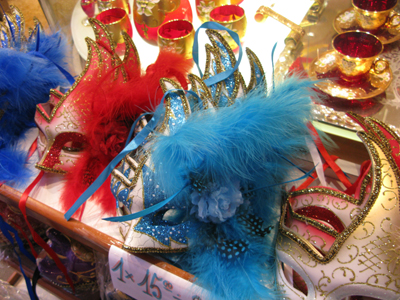
Once at the bus terminus, we exit and walk across a bridge and we are in Venice! What a lovely, wonderful old city. Everywhere we turn there is majestic beauty. Kathi has decided that we must bring home Venetian Masks and one of the first shops we go past makes and sells masks. We go in and look around and ask questions and prices. We decide to keep on looking, remembering that it's not wise to buy the first thing you see (of course we did purchase the first rings we saw in Florence and we do, eventually come back to this shop to purchase masks the following day.)
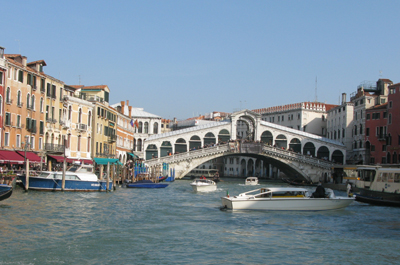
Walking on, we cross bridges over exquisite little canals and eventually come to the famous Rialto Bridge over the Grand Canal. We notice the Hotel Marconi located next to the gondola docks and go inside for a quick look. It's a charming small hotel located next to the Rialto Bridge and Kathi and I decide that the next time we come to Venice, we will stay here. (Two years later, after forming VITA Digital Productions, our first filming trip is to Venice and we do book the Hotel Marconi in one of its two balcony rooms overlooking the Rialto Bridge and the Grand Canal.)
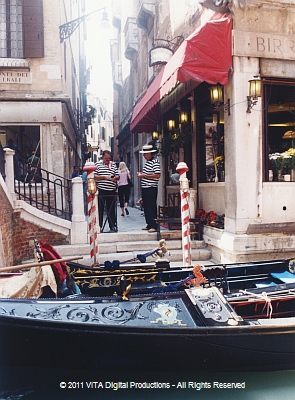
The city of Venice is everything we had expected and more. I try to imagine what it would be like to live in a city this picturesque, this historic, this beautiful but can't. That idea is so far from my experience that I can't even imagine what it would be like.
A friend described Venice with the words, "... faded, shabby, beautiful, and quaint elegance."
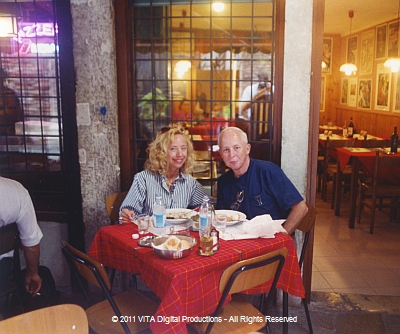
Kathi and I stop at a little restaurant along one of the narrow streets, choose a table outside under the awning, and enjoy a delicious supper. While we eat, we watch the people go by and savor the early evening ambience. It doesn't get much better than this - eating a lovely dinner, outside under an awning, at dusk, in the romantic city of Venice. As we enjoy this idyllic setting, Kathi is aware, I am sure, that tomorrow at this time, while riding in a gondola, I will ask her to marry me. Finishing our meal, we wander on through the magnificent streets of Venice. Returning by bus to the hotel, we retire, anxious for tomorrow and all of the events to come.

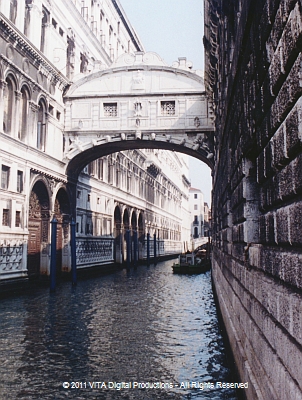
Day 9 - Tuesday, June 29, 1999 - Venice:
Breakfast in the hotel dining room. Piero, our tour bus driver, is ready to help us into our bus. We drive to the marina where we board our own vaporetto. Speeding through the Venetian harbor, we see a Greek ferry boat loaded with cars and tourists. After a 15 minute boat ride we arrive at St. Mark's Square, dock and meet our tour guide, Sergio.
One of the first sites we view is the famous "Bridge of Sighs" and I photograph it from a small bridge. It is exquisite. Our tour group enters the Doge's Palace, where photography is prohibited and we observe with awe the impressive paintings which adorn the walls and ceilings. Then we pass through the Bridge of Sighs and into the old jail with cells in which Casonova, among others, was imprisoned. The tour guide tells us that Casanova was the only inmate to escape from the jail.
Exiting the jail and crossing again through the Bridge of Sighs, we leave the Palace and go down a long set of marble stairs.
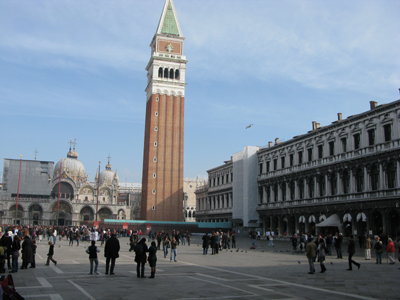
We then walk to Piazza San Marco and, while explaining the history of the Cathedral of San Marco, our tour guide has an unfortunate accident involving a pigeon. Entering the Cathedral, we marvel at its gold mosaic tiles covering the ceiling and walls. Even the floor, which undulates from uneven settling, has intricate mosaic geometric designs.
Leaving the Cathedral, we walk a short distance, go over a small bridge and enter a glass factory. Actually it's not a factory at all, only a glass store with a small glass blowing demonstration. Because of the threat of fire, real glass factories were moved to the island of Murano long ago.
After the demonstration, we enter the showrooms and salesmen are everywhere. Kathi purchases a vase for a friend and I purchase a necklace and ear rings for my daughter. While discussing the vase purchase, we are introduced to Armando who lived in North Carolina for 28 years. What a small world. Kathi inspects some hand blown glass goblets there but insists that she will only purchase them on the island of Murano.
As we exit the glass factory, we see a tour guide sitting near the exit and I believe I see someone slip him an envelope. I've suspected that the guides receive a percentage from the purchases made by members of tour groups in each of the stores. Months later, back in the United States, I see a program on television which confirms this suspicion. Tour guides have a lot of leeway in making decisions about where the tour group will be taken, where they eat the optional dinners at night, which restaurants they eat at during the day, and where they are taken to shop. Their percentages along with the tips which almost all tour members will give them at the end of the tour, plus salaries from the tour companies must all add up to a substantial amount.
I must state, in defense of the tour guides that this is just business as usual in Italy, the way it was, is, and probably always will be in this country. However, tour guides work hard, are away from their families for weeks at a time, and can turn an average tour into an exceptional experience.
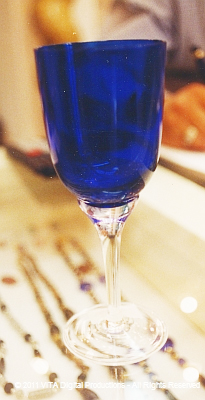
After leaving the glass factory, we are on our own for the rest of the day. Vincenzo has arranged an optional gondola ride for the afternoon and then an optional dinner somewhere. Kathi and I choose to do neither. We wish to have a gondola all to ourselves and it must be at sunset.
So we walk to the east side of the city to catch a vaporetto to the island of Murano. The boat ride takes around 15 minutes and after a stop at the island of Burano (famous in its own right for handstitched lace), we arrive at Murano. Kathi wants to purchase a set of glass goblets and have them shipped back to the states - but they must be purchased on Murano, famous the world over for glassmaking.
We enter the first glass store we come to. After leisurely examining their glassware, Kathi eventually chooses a beautiful cobalt blue goblet and then the bargaining begins. The young salesman states a price and Kathi say's she can't afford the price quoted for a set of six. Negotiations appear at a stalemate. So I ask Kathi, "What if he comes down to (naming a price)?" and she reluctantly agrees. And to my surprise, the salesman agrees also. So she places her order for six goblets. They will be shipped directly to the United States. We Americans are amateurs at negotiations with Italians. But, in the end, we felt we paid a reasonable price for the hand-blown cobalt blue goblets.
I photograph a close up of the goblet to insure that we get the same type later. Then the sales clerk asks Kathi to initial the bottom of the goblet and tells her that that very one, along with five additional matching ones, will be shipped to us. Initialing the goblet will prove that we receive the exact same goblet that we have chosen. After our purchase, the salesman takes us on a tour of their upstairs display area. They certainly have some exquisitely ornate glassware here, some of it is extremely expensive. I use the Steadicam to videotape much of what he shows us there.
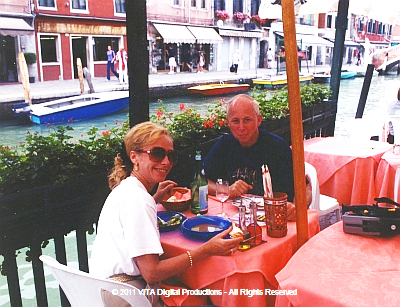
Leaving the store, we walk along the canal, cross a bridge and choose a little sidewalk restaurant for a late lunch. Seated under an large umbrella, immediately beside the canal, we have our meal. What a truly beautiful location. The only factor which annoys me about meals in Italy is the substantial charge for water with one's meal. Water in Italy always comes in green bottles similar to wine bottles.
Kathi remarks that this is the best insalada mista (mixed salad) that she has ever had. I have spaghetti and am somewhat surprised to realize that I'm not tiring of eating pasta almost every day, in fact, I am constantly discovering new forms of pasta to enjoy. Penne pasta is quickly becoming my favorite. It is also interesting to learn that Italians don't put a lot of sauce on their pasta - at least not as much sauce as I'm used to getting in restaurants back home. And in using less sauce, I realize that you are able to enjoy the subtle taste of the pasta itself.
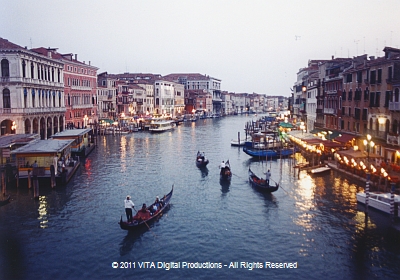
Leaving the restaurant, we cross back over the canal and stop in a few glass shops where I purchase two beautiful Murano glass pendants for Kathi and my youngest daugher. Returning to the vaporetto dock, we await our boat back to Venice.
Once on the boat, we take a seat at the stern and enjoy the view. Our vaporetto is taking the long way back and our course takes us around the perimeter of the islands that comprise the city of Venice and past the Venice yacht club. After more than a half an hour's ride, our vaporetto takes us up the Grand Canal and we get off near the Rialto Bridge. It's seven thirty PM, sunset is approaching and we decide to find a gondola.
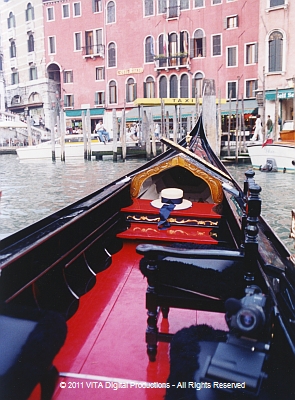
Crossing the Rialto Bridge we spot a beautiful black, shiny gondola just returning with its passengers and gondolier. As the passengers exit, I approach the gondolier and ask, "Quanto costa?" He responds with a quote which is much above that which Vincenzo has advised me to pay and I make a counter offer. He shakes his head and states a slightly lower price, but still substantially above Vincenzo's advised price. I hesitate, almost walk away, but quickly capitulate - I am aware that prices go up at sunset. But, I state, "Por trenti (30) minutos?" He agrees. We step into his gondola.
It is immaculate, its black varnish polished to a mirror-like sheen. On a small wooden seat near the front of the boat rests his iconic gondolier straw hat complete with black ribbon. Kathi and I are seated on blood red back cushions, shaped like hearts. He, of course, wears the traditional gondolier garb, black pants, a white tee shirt with wide horizontal black stripes. Small golden cherubs adorn the boat.
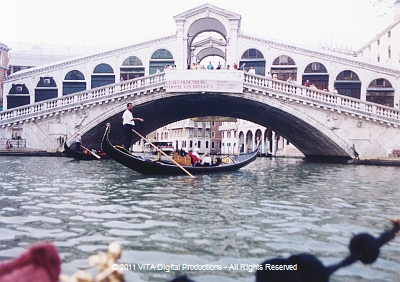
He pushes off and the boat backs out into the Grand Canal, it turns and we proceed under the Rialto Bridge. Everything looks different from the gondola. Kathi and I are filled with excitement; we are after all, in Venice, on a beautiful gondola, cruising on the Grand Canal under a full moon, and at sunset!
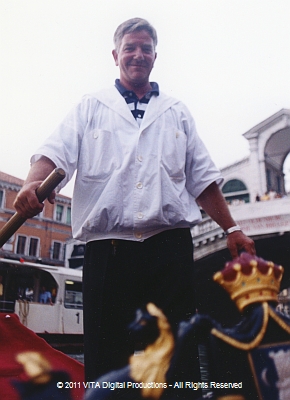
Our gondolier gently turns his gleaming vessel and we enter a side canal. The canal is narrow, the walls of the ancient buildings are several stories tall. We are in the center of a large city but it is eerily quiet - all we hear is the splash of the gondolier's long oar hitting the water. As we look upward, we see flower boxes everywhere. Everyone has flowers on their windows and balconies.
Several times, when approaching a blind intersection, our gondolier cries out, "Oey-Yaah," and listens for an answer, warning other gondoliers that he is preparing to turn a corner, and possibly directly into their path. Our ride takes us under many small bridges and through picturesque canals with water lapping right up to the door openings. It is obvious that the water level is rising - - Venice is slowly sinking into the water that surrounds it.
As we pass other gondoliers, our boatman carries on short conversations with them. At last the gondola turns to the right and I can see in the distance the Grand Canal and the Rialto Bridge in the distance.
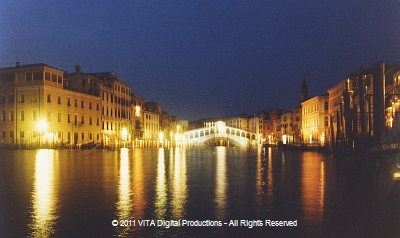
As we glide up the Grand Canal, the sky is a rich dark blue, street lights are on and the setting is magical. We dock, I pay the gondolier, thank him and we walk a short distance to the top of the Rialto Bridge and stop to view the enchanting scene below; Venice at twilight with hundreds of lights reflected in the water. We watch below as our gondolier paddles his craft back across the Grand Canal to the other side and awaits his next passengers.
Kathi and I walk back through the dimly lit alleyways and to the bus station and finally arrive back at our hotel. What an extraordinary day.

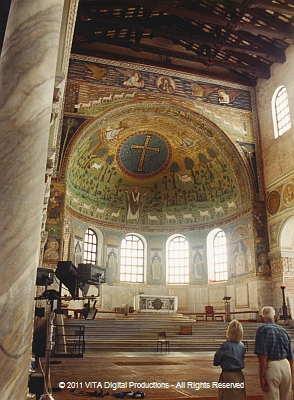
Day 10 - Wednesday - June 30, 1999: Venice to Ravenna to Assisi:
Up and to breakfast in the hotel dining room. Then onto the tour bus and we leave Venice, driving along the coast, through tidal marshes, and next to the Adriatic Sea. In Ravenna we stop for coffee at a little roadside café. After our snacks are finished, we walk across the street and enter the 6th century Basilica of St. Apollinaris in Classe. Vincenzo purchases our tickets and, after a short history of the basilica from him, we enter the sanctuary itself.
The church has beautiful gold mosaics on the walls and ceilings. Back on the tour bus, Piero, our driver, makes a wrong turn and has to back out of a dead end street - the only mistake we ever see him make on the tour. Back on the highway, we continue on, crossing the Apennine Mountains and heading toward today's destination, the little hilltop town of Assisi.
Stopping at the ubiquitous "Auto Grill," for lunch, we stand in the usual slow-moving lines. The Italians have devised a hellishly complicated system for ordering food in these types of shops: a customer is required to stand first in one long, slow moving line to order and pay for the items one wishes to purchase, then, taking the printed ticket they have received, they walk a short distance only to stand in another long, show moving line.
Finally after waiting patiently in the second line, they are waited on, and handing the receipt to the cook who then, and only then, begins to cook or otherwise prepare their order! And when several tour buses arrive at an "Auto Grill" at the same time (and this happens more often than not), you can only imagine the needless waiting and long lines that ensue. Kathi and I find tables on the terrace and eat our lunch overlooking a small stream that will become the mighty Tiber River.
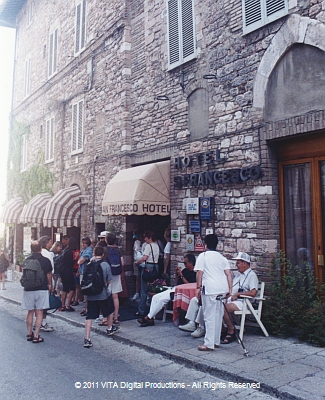
Arriving in Assisi, we leave the bus and our luggage half way up the mountain where we use a covered escalator to get our group to the top of the mountain.
Once there, we have to walk for twenty minutes through the city gate and on to the far side of the little town, where we check into our hotel, the San Francesco, a charming 13th century converted monastery. Our bags arrive and after some unpacking, Kathi and I walk the short distance to the Basilica of St. Francis. The Basilica and town were heavily damaged during an earthquake two years ago and rebuilding is still going on.
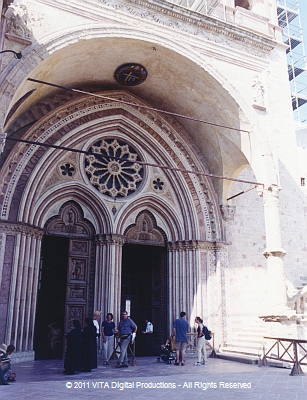
Upon entering the lower Basilica (the upper Basilica is closed for repairs) Kathi and I are touched by the obvious loving care taken in adorning this simple but large church built to honor St. Francis. Hand painted stone supports stretch from the floor to the center of the ceiling and it is clear that many thousands of hours of painstaking care went into their construction.
This church is on a more human scale than either St. Peter's in Rome or the Duomo in Florence and therefore, at least for me, has a greater emotional impact. I can actually "feel" the love and devotion which went into its construction and I am moved to tears because of it. Leaving the sanctuary and entering the crypt in the back, we learn through displays and artifacts of St. Francis and the tremendous sacrifices made during his life.
Returning to the sanctuary, I see someone taking photos in total disregard of the "No Photography" signs which are posted everywhere, and I glare at them and shake my head, "No." It seems such a sacrilege to be doing anything to despoil the atmosphere of this sacred place. I, of course, take no photographs inside - this is a special place.
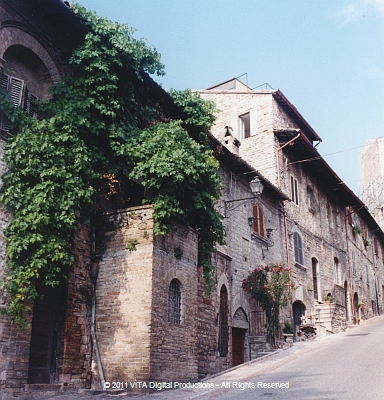
Leaving the Basilica, Kathi and I walk through some of the back streets of Assisi. What a charming town. Everything is built of stone here, all the homes, apartment houses, shops, and even the streets. And the door of each house is unique. I stop frequently to take photographs of the beautiful doors and Kathi patiently waits for me to do this.
Approaching the top of a hill, we see a little boy with a large dog. I start videotaping both of them, and about the time I get about 4 feet from the boy, the dog lunges forward stopping about 12 inches from my body and growling viciously. The little boy just barely able to hold on to the dog's leash, I walk quickly out of harm's way. What a close call.
Our dinner tonight in the small hotel dining room is memorable. The wait staff is very attentive and helpful, the food is delicious and second and even third helpings are offered to us. As we travel around Italy during our Globus tour, staying in different accomodations and eating in different restaurants, we realize that we are sampling regional dishes and that the only constant is that the food is prepared with fresh ingredients and is always delicious.
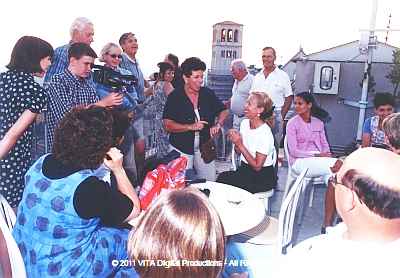
Around twilight Kathi and I decide to check out the view by taking the small elevator to the top floor; we exit and climb some stairs to the large rooftop patio. A spectacular view stretches out below us. The only building higher than our hotel, and therefore with an even more breathtaking view, is the nearby nunnery and several nuns are, in fact, standing on their balcony enjoying the view.
Soon others in our tour group arrive on the patio to enjoy the view. By twilight most of our group are present and I decide to take a group photo. Rushing down to our room, I return with my mini tripod and self timer along with my camera and flash. Setting everything up on a table, I assemble our group and take two photos at sunset with the spire of the basilica in the background. Afterwards, we all sit around the tables talking, relating our travel experiences and having a wonderful time enjoying each other's company. I hand Justin my Steadicam and camcorder and he begins to videotape the conversation. Harold tells a few of his classic "Thibodeaux and Boudreaux" Cajun jokes and we all laugh at his antics while he acts out the roles.
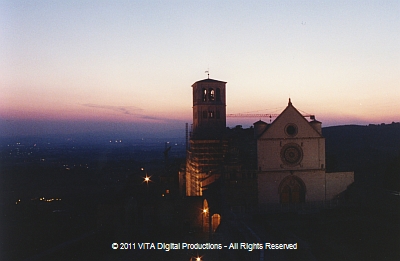
As the sun sets and the sky turns a rosy red, we realize what an exceptional evening this truly is. After the sun goes down, we continue sharing stories and experiences until late into the night.
Looking back on this trip, Kathi and I were so very fortunate to have such a warm and friendly group of fellow travelers.

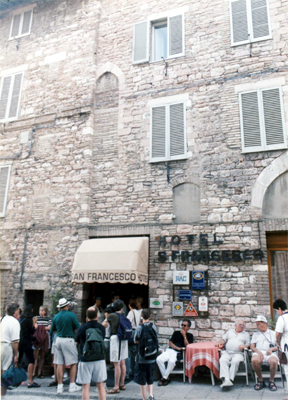
Day 11 - Thursday, July 1, 1999 - Assisi to Naples to Pompeii to Sorrento:
Breakfast in the hotel dining room and then a short walk down the hill to our tour bus (why did we take the long way up and the short way down the mountain - and not the reverse?) We get an early start today because our next hotel in Sorrento is 300 miles away.
Traveling through the outskirts of Naples, Vincenzo asks if we need a bathroom stop before our stop at Pompeii, informing us that Pompeii is still an hour away. We all respond affirmatively and he describes our upcoming strategy: we will stop at a cameo factory which has excellent free restrooms. But in order to utilize the free restrooms, we will have to first watch a short demonstration of how cameos are made and then pretend that we are interested in possibly purchasing some of their stock. Then and only then, may we go downstairs and use the restrooms. "Oh, what a tangled web we weave, when first we practice to deceive." Everyone understands what we are to do and we exit the bus and enter the cameo factory.
Actually, the demonstration was quite interesting and their cameos were beautiful: so nice, in fact, that several of our group actually made purchases. And the restrooms were clean and …… better yet, they're free! Later, I begin to suspect that Vincenzo's objective all along was for us to visit the Cameo Factory - he used a "carrot" (the bathroom) in order for us to agree to stop at what otherwise would have appeared to be an obviously unnecessary commercial visit.
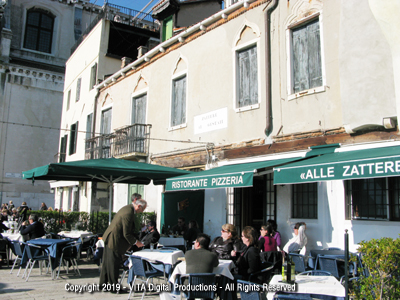
Restrooms are a problem all over Italy. First and most importantly there's too few of them. Surprisingly, many stores and restaurants do not have public facilities at all. And when they do, you are expected, actually required to purchase something before using them. On several occasions, Kathi and I entered a café or restaurant with the restroom our main goal, only to discover after placing our order, that there were no public facilities. Kathi, who was never fond of fast food restaurants, learned on this trip to appreciate the McDonalds Restaurant chain, primarily because they always had free, clean, American style toilet facilities.
Second, their hygiene leaves a lot to be desired - one is apt to find facilities which are everything from untidy to absolutely filthy. And third, you are expected to pay to use them. Five hundred lire is the standard fee expected everywhere. In fact, restrooms appear to be the only reason that 500 lire coins exist. Since sales or V.A.T. tax is already included in the price quoted for goods and because the price quoted is always in multiples of one thousand lire, there appears to me to be no other use for the 500 lire coins. I did learn, however, that it was wise to keep an ample supply of these 500 lire coins available in my pocket at all times.
Usually upon entering the restroom, one first passes through an anteroom in which a lady attendant sits with a plate or bowl placed prominently on a counter. Her position as a sort of "gate keeper" requires you to pass directly past her and her "tip" plate before you can approach the next room which contains the small stalls. In most restrooms there are totally separate facilities for men and women but in at least a few places we visited in Italy, there was only one anteroom and one secondary room in which men and women waited side by side to enter the next available stall. It was, not surprisingly, a little disconcerting to Americans.
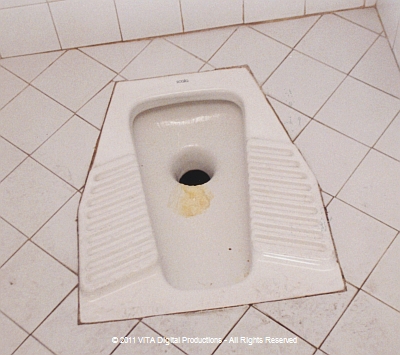
A warning to readers: I am now going to discuss the actual mechanics of Italian toilets. Those readers who prefer may skip these two paragraphs, otherwise, for those remaining brave souls, read on. Italian toilets have some apparent design deficiencies. First, they are smaller and shorter than their American cousins but their biggest fault lies in something known as the "water pan," the quantity of water that is kept by the toilet between flushes. Italian toilets just don't have a "water pan" and they should. They instead rely on a greater force and quantity of flush water to solve the problem - which it usually doesn't. Therefore the ubiquitous toilet brush was beside every toilet I visited - patrons were expected to solve whatever problems the flush had left unfinished. And, human nature being what it is, those problems were usually left behind for the next patron.
But the most puzzling question regarding water closets in Italy was the unusual flat porcelain floor structure which one encountered in place of traditional commodes from time to time. This structure was constructed of glazed white porcelain and was flush with the floor of the stall. It had molded into its sides, two corrugated foot placements with a gently sloping surface between, leading into a hole, all without any sort of "water pan." Mounted on the wall nearby was the flush valve. At first I assumed this was some sort of male urinal but quickly discovered that women's restrooms had them too, so the mystery continued. Was one supposed to squat when using this appliance? I attempted this once without much success in the restrooms atop St. Peter's Basilica in Rome. Yes, atop St. Peter's in Rome. There are restrooms on the roof of St. Peter's for use by visitors who climb to the top of the dome. In any event, I never mastered their proper usage and continued to wonder why Italians would bother to install them when traditional commodes would have cost about the same price and been much more useful.
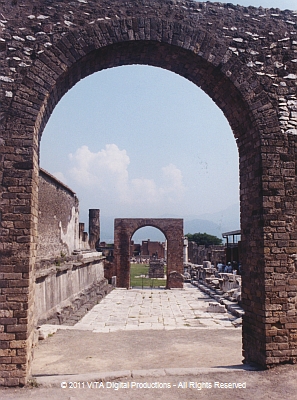
Arriving at Pompeii, our group exits our tour bus and meets our guide. Entering at the Marina Piccolo gate, we pass through an arch and find ourselves inside the ancient city. The stones that pave the streets have grooves worn into them by thousands of chariot wheels. The first thing one notices about Pompeii is the dust - it is everywhere. Volcanic dust preserved the city when Mount Vesuvius erupted on August 24th, 79 AD, and it seems to be attempting to slowly reclaim it.
Our group enters the basilica and marvels at its size. I am surprised to learn that most of the marble columns are not marble at all, merely bricks cemented into a columnar shape and then covered in a cement made with marble dust. The ancient Romans were certainly creative, they not only invented cement but they invented imitation marble columns as well. The city has sidewalks with raised stepping stones at street intersections to prevent soiling one's feet in the street (which was utilized as a sewer), but also to control the chariot traffic as well. The raised stones functioned a little like today's "speed bumps" necessitating the chariot drivers slowing down as they entered the intersection in order to maneuver their horses and vehicle accurately between the carefully spaced raised stones.
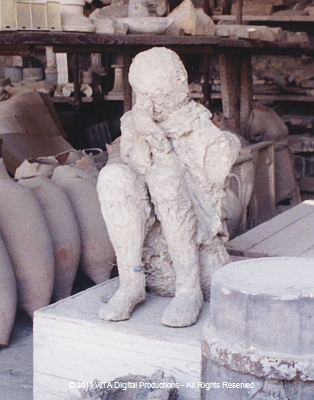
Our guide takes us to the Forum, and there along one side of the ancient gathering area, I see my first "cast." I had, for most of my life, been intrigued by these "casts" which I had seen photographs of in books. They are chilling artifacts of that day in August in 79 AD when Mount Vesuvius blanketed the city in poisonous fumes and ash and killed the few remaining occupants of Pompeii.
Discovered early in the excavation of the city, diggers noticed cavities in the hardened ash in which skeletons were located. Someone had the brilliant idea to pour liquid plaster of Paris into the cavity, wait for it to harden and then remove the ash from the resulting cast. Once cleaned, the early archeologists were amazed to see before them a plaster cast in the shape of a human in their death throes, exactly as they had died on that terrible day almost two thousand years before.
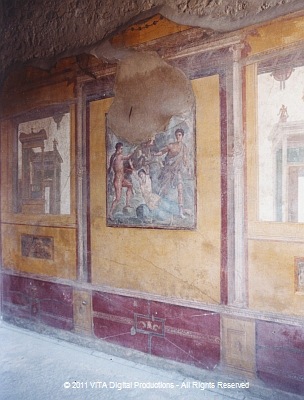
Today, there are many of these plaster casts located throughout Pompeii, some of children and even of dogs. Today's tour of Pompeii lasts only about 2 hours - far too short for me. I'll return later to Pompeii during our five day extension for a much longer examination and photography session. So, after our mini-tour of Pompeii, we return to our tour bus and proceed on to Sorrento.
Once at our hotel, the Sorrento Palace, Kathi and I check in, (we are assigned room 89), have time to relax a little, and check out the hotel and grounds and before getting dressed for dinner in the hotel's dining room. And dinner is quite extraordinary - four courses beautifully served - and delicious. After dinner, most of our group gathers on the hotel's large marble terrace which overlooks the Bay of Naples. The view is breathtaking, the night magical, and Kathi and I talk and joke with our friends until late into the night.

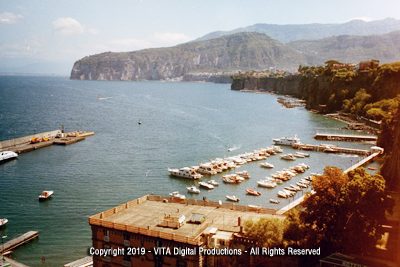
Day 12 - Friday, July 2, 1999 - Excursion to Capri:
Up around 7 for breakfast in the hotel's dining room - what a beautiful view of the Bay of Naples from here. This hotel does everything well -- flowers on each table - everything is immaculate and tasteful. Breakfast is the usual: croissants, hard rolls, jellies, cereals, sliced boiled ham, cheese, apples, orange juice, coffee, hot chocolate, and bottled water - be careful, some is "gas," some is "no gas" and there's a big difference between the two!
At this hotel our group is eating breakfast with other tour groups; in most other hotels where we've stayed the Globus tour group has had our own separate dining room for breakfast. We've assumed that each tour has negotiated a specific breakfast menu and different tours get different choices, some more elaborate than others. Members of our group were always attempting to sneak a peek at another tour's breakfast line to determine if they were getting more or better choices than we were but we were never able to come to a definitive answer. Some days, not all, I would put a hard roll or two with a slice of ham in my back pack for a snack later in the day. And since we always had a small refrigerator in our room, the snack was usually stored there until it was eaten.
Then downstairs and onto a small bus -- our tour bus cannot negotiate the sharp curve down to Sorrento's Piccolo Marina. Once at the Piccolo Marina we board our jet boat and embark for the Isle of Capri.
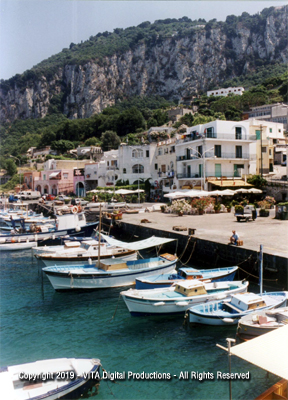
After a 30 minute jet boat ride we arrive at Marina Grande, the main port of Capri. During the later half of the 19th century, Capri became a popular resort for European artists, writers and other celebrities. And it still is so today.
Here our group gets onto another boat, much smaller, to motor to the area outside the famous Blue Grotto. Here we wait for "negotiations" to be completed -- people have to be paid various fees. At last the small rowboats pull up to the side of our boat and our group is transferred, one by one, onto the small craft. Once full, each rowboat traverses about 500 feet and attempts to enter the Grotto through a very small opening in the rock.
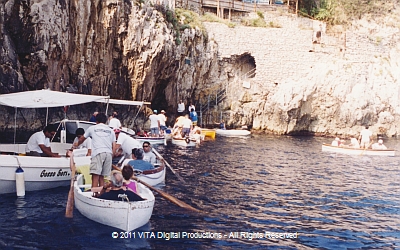
Harold, Margaret, Kathi, and I each get into a small boat and our skipper tells us to lie as flat as possible in the bottom of the boat. We comply and he rows the boat to the mouth of the Blue Grotto - an opening which is only about 3 feet high at its maximum as the ocean waves rise and fall.
Timing his move carefully, our skipper grabs onto a chain which is stretched along the top of the opening and runs inside and pulls hard propelling our boat and its passengers through the small opening and inside the cavern. Once inside the cave becomes magical. The Grotto is completely dark inside but the water beneath us glows with an irridescent blue hue. It's as if there were hundreds of giant flood lights below all pointing straight up. We were fortunate today, because there are times when the Blue Grotto is inaccessible due to high tides.
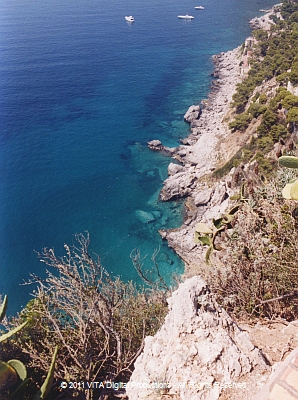
Nero used to visit the Blue Grotto when he had a summer palace on Capri two thousand years ago. After spending a few minutes rowing in a circle around the inside it is time to exit the Grotto through the same (and only) opening through which we entered earlier. So we four passengers lie down again as flat as possible and our skipper once again carefully times his pull on the chain so that we exit the opening with the maximum clearance and suddenly we're back out into the sun. A quick row back to our boat, another transfer from the row boat to the larger boat, and it takes us back to Marina Grande of Capri.
Walking a short distance to the funicular, we travel up the side of the mountain and arrive at the town of Capri. Our guide, Pasquale, gives us a walking tour of the little town and eventually takes us to the cliffs overlooking the ocean. Looking down onto the rocks onto which Nero once had slaves thrown, we are amazed at the clear, azure blue water below. What a beautiful view.
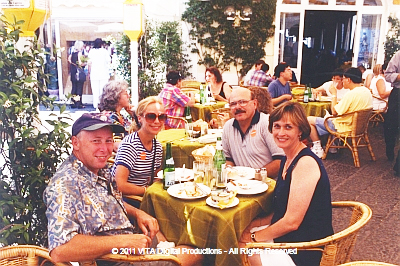
After the tour is over Harold, Margaret, Kathi and I have lunch at one of the outdoor restaurants in the town's center. Kathi, of course, has to finish her meal with a dish of gelato. Harold tells a few more of his "Boudreaux and Thibodeaux" jokes which we enjoy hearing so much.
A decade later, Harold and Margaret invited Kathi and me to visit them at their "camp" on Six Mile Bayou in southern Louisiana. For those few days, Harold regaled us with more of his "Boudreaux and Tibodeaux" stories and was our tour guide as we filmed from his boat in the bayou. Wonderful friends and wonderful memories.
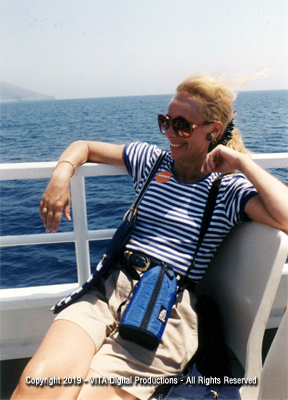
Our group reassembles at the appointed time and we descend the mountain on the funicular. Back on our Jet boat for the trip back to Sorrento, Kathi and I decide to sit on the top deck and enjoy the sun. Once underway, a young man circulates selling cold soft drinks at inflated prices. A few minutes later he returns, this time selling large beach bags bearing the name "Capri" stitched on the side.
He circles the deck numerous times without any success attracting buyers. On his third circle of the deck, I remembered that we needed a present for our good friend Barbara, back in North Carolina and motioned for him to come over. I examined his bags and decided they were a good buy so I bought two, one for Barbara and one for Kathi.
Other members of our group who were also sitting on the top deck watched me purchase these two bags and hands went up as soon as the young man had finished with me. He then went from one person to another, eventually selling every one of his bags and had to go below to get more. He probably sold a total of twenty to twenty five bags on the top deck as a result of me purchasing the first two.
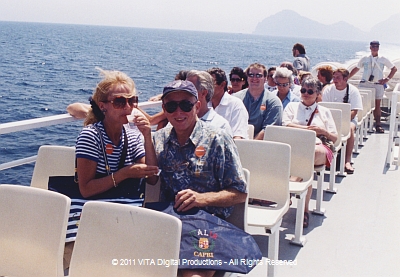
Chick, one of our friends in the tour group from Brooklyn, told the young man that he should give me a "commission" for instigating all of his sales. The young man came over to me and asked if I'd like an Expresso as my "commission" and I said, "Yes." He went below and returned with a small cup and presented it to me as a gift. I said, "Thanks" and gave it to Kathi. Everyone on the tour laughed about "my commission" and all the sales that had resulted from that initial purchase.
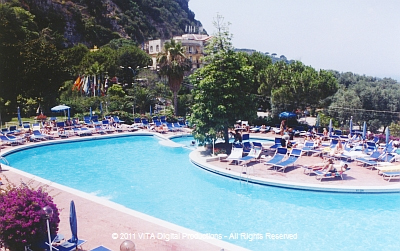
Back in Sorrento, we returned to our hotel. Kathi wanted to spend the rest of the afternoon getting some sun at the pool. I decided to accompany her and we eventually found two chaise lounge deck chairs - Kathi's in the sun and mine in the shade. I had my sunglasses on and I relaxed and observed the others around the pool. It didn't take too long for me to notice several ladies sans top. I had never realized that soaking up the shade around the pool could be so much fun.
After an hour or two of sunning herself, Kathi decides to go in. We stand up to collect our belongings and I notice one of our friends from the tour group in one of the second story windows starring intently toward the pool area. I wave to him but can't attract his attention he is gazing so intently at people around the pool. Finally he sees me and embarrassed, takes off his glasses and makes an exaggerated motion of blowing and cleaning them. Kathi and I laugh and we return to our room.
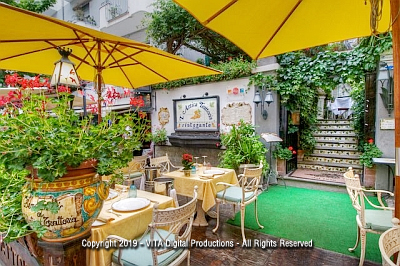
After showers and dressing, Kathi and I decide to walk down the hill to the village of Sorrento and find a nice restaurant for dinner. Since the Italians normally eat dinner between 8 and 9:30 PM, we usually don't have any trouble finding a table at 7:00 PM. Locating L'Antica Trattoria on Via Giuliani, 33, a restaurant that someone in our group has recommended, we go inside and discover Peter and his wife Lainie at a table there. They ask if we'd like to eat with them and we readily agree.
Peter and Lainie are such an interesting couple - they're from Phoenix, and we both enjoy Peter's sense of humor. We had a table outside under a grape trellis, lots of beautiful flowers and plants and classical music playing in the background. Dinner is delicious and the conversation is delightful. The dessert was Chocolate Tartufo - scrumptious!
A wonderful evening. Later, after dinner, we four walk around the town center. Sorrento has many little shops lining back streets and is crowded with pedestrians strolling in the cool night air. Around 10 PM, the four of us get a Mercedes taxi cab to take us back to our hotel and then join Harold and Margaret on the terrace for some dancing. Another memorable day.

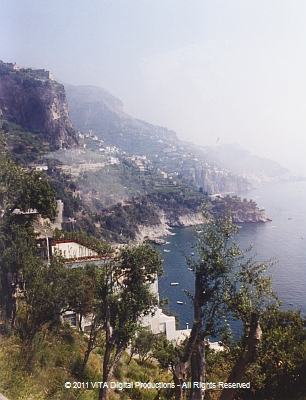
Day 13 - Saturday - July 3, 1999 - Down the Amalfi coast to Paestum:
Up early and to breakfast in the Sorrento Palace's beautiful dining room with that wonderful view overlooking the Bay of Naples. We set the clock to get up early to see part of the group off to the airport, since today is the official end of the Globus tour - about 12 of us have purchased the 5 day extension in Sorrento and will therefore be staying behind. All along, this has been a very congenial crowd and we've all hit it off well. After breakfast we go downstairs to the tour bus to officially say goodbye to our friends. The ones leaving for home form a sort of receiving line to dispense goodbye hugs and congratulations on our engagement. Kathi and I are sorry to see them leave.
So now that our tour is over, and for the first time essentially alone, Kathi and I head off for a private "adventure." We walk about a mile down to Sorrento's bus station and purchase tickets from Sorrento to Amalfi (one way the fare is about 3,000 Lire - about $1.50). This is a one and a half hour ride along the Amalfi Coast: one of the most beautiful - and hair-raising -- drives in the world.
No one told me, and I didn't stop to think, that since our ride would be south, the best seats would be on the right hand side of the bus. So, without thinking, we choose seats on the left side. Poor choice. Our driver really knows what he is doing. In some spots, there is no more than a 6 inch distance between the bus and the buildings on the side of the drive. At one point, our bus meets another blue SITA bus just coming out of a hair-pin curve. There is not enough room to pass, so our driver backs our bus about a half a block down the Amalfi drive - and doesn't even break a sweat. Shortly before arriving in the town of Amalfi, two small children sitting in front of us become ill from the extreme motion of the bus.
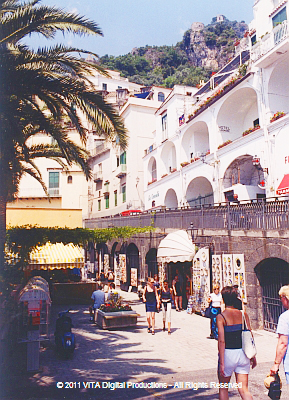
Fortunately for us, we will change to another bus in the coast town of Amalfi. With about 40 minutes to kill, Kathi has a gelato (es veramente!) and we walk over to the piazza. On the way back to the bus station, we are motioned over to a (clean) restroom by an old Italian sitting under an umbrella in front of a tearoom. The usual bathroom gratuity is given (about 500 Lire or 25 cents per person). The exchange rate during this trip, by the way, is very favorable to the dollar - around 1880 to 1900 Lire to the dollar.
We leave shortly after noon for Salerno, about an hour's drive south of Amalfi. In Salerno, we walked to a local bus station and found a little bus headed for Paestum, our ultimate goal. We are the only ones on the S.C.A..T. bus who speak English, the rest being simple country folk. In addition to the driver, there is a ticket taker on this bus who speaks not a word of English. Using the Italian I had learned in my Conversational Italian class, I am able to make him understand that our destination is Paestum and he is able to make me understand that he will tell us when to get off. Just before we exit the bus, I am able to ask him in my broken Italian, "What time will you return?" and understood him when he answers, "4:30." We have less than 2 hours to explore the ruins at Paestum.
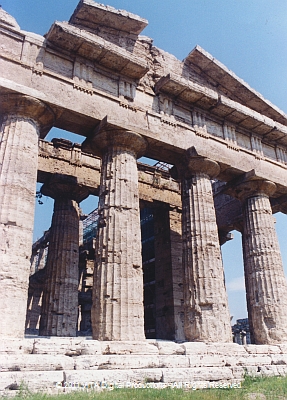
The ruins at Paestum, we suspect, are seldom visited by the average American tourist. For one thing, this area is far off the beaten track and is in a rather remote location. Also, most tours that do get this far south in Italy concentrate on the more famous ruins at Pompeii.
Here in Paestum, there are three intact Greek temples in excellent condition. Kathi and I walk about a half mile from the bus stop to the first of the three temples and I begin my photography. For most of the time while we are here, we have the site almost to ourselves. We walk through the ruins of the ancient town, one of whose temples is a shrine to Poseidon. The inhabitants died long ago, victims of malaria.
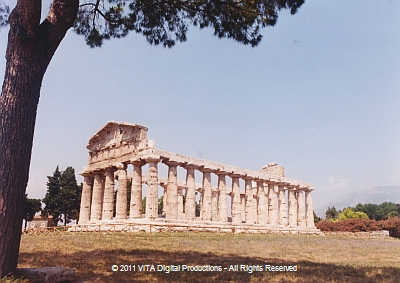
After exploring the ruins at Paestum, Kathi and I quickly return to the crossroad where the bus is scheduled to return at 4:30. There is just no traffic in sight - I certainly hope I understood the ticket taker's Italian. Otherwise, Kathi and I will have substantial difficulty in getting back to our hotel in Sorrento. At precisely 4:30 PM, the small bus appears in the distance. The bus stops for us and we have a pleasant ride back through the countryside and on to Salerno.
Once in Salerno, we once again wait for another bus which takes us back to the town of Amalfi where we again switch to yet another bus which returns us to Sorrento. We are back in Sorrento at 10:05 PM exhausted but fit enough to walk the two miles back up the hill to our hotel.

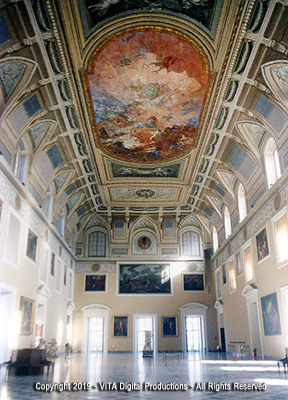
Day 14 - Sunday - July 4, 1999 - Excursion to Naples:
Up later than normal and to breakfast - we are, after all, for the first time on our own and not part of a tour group. After breakfast Kathi and I walk down the hill to the Sorrento train station and purchase two round trip tickets to Naples. Today, we're traveling to the Museo Archeologico Nazionale in Naples, the depository of most of the remaining treasures from Pompeii. When first discovered in the 1700's, Pompeii was covered by almost 30 feet of hardened volcanic ash, cinders and stone.
In 1748, a peasant digging a well in a vineyard struck a buried wall. Others followed suit and, digging tunnels throughout the ancient city, removed and clandestinely sold many of the statues and works of art during the next hundred years. Beginning around 1860, archeologists carried on a systematic uncovering of the city block by block but by this time, many of the original Pompeian works of art were already missing and lost forever. Much of what treasures remained were removed to the archeological museum in Naples.
We meet a nice family of four from Australia, and enjoy a conversation during which, we exchange travel tips. The lady in the group, Kathi notices, is busily working on her journal. Our train is part of the Circumvesuviano Line and our trip ends in the Naples train station at 12:10 PM. From there it is a few blocks walk to the Metro - the subway system which we take to the Museo. There are few people on the street and we walk quickly. Sunday is an excellent day to spend in a museum - no tour buses and very few tourists.
Once at the museum, we first enter a separate exhibit called "Homo Faber" representing a day in the life of Pompeii. In the first exhibit room I take out my camcorder and begin to tape a fresco and am stopped by a guard - photography is not permitted here. This is unusual for almost all museums we've visited so far in Italy have permitted photography as long as you did not use a flash or a tripod. So, I put away my camcorder and camera and we examine the rest of the exhibits at leisure. Kathi pulls water using a model Archimedean wooden screw.
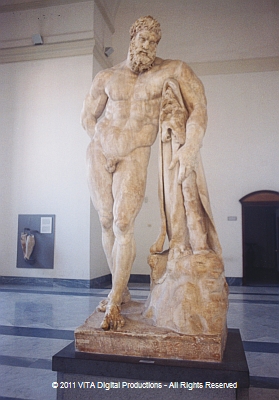
Leaving the special exhibit, we take a lunch break and popped around the corner to McDonalds. While I stay with my traditional fare (a Big Mac), Kathi has a shrimp salad and a chilled fruit cup. Even though ice in beverages is still the exception rather than the rule in Europe, you can always have your McCoke with ice! (Kathi begins to appreciate McDonalds for the first time in her life.)
Refreshed and ready for more exploration, we next enter the main part of the Archeological Museum which houses the permanent exhibit. This is a jewel and contains most of the recovered wealth of Pompeii. The excavated site is virtually a city of roof-less buildings, so it was necessary to remove most of the frescoes, mosaics, and statuary to a more protected place. The Pompeiian mosaics are breathtakingly lovely and tell the story of a highly sophisticated, patrician population. As their art illustrates, the men and women of Pompeii appreciated culture, technological ingenuity, and aesthetics. We have the legacies of Ovid and Pliny the Elder to enrich our understanding of the life of Pompeii prior to the eruption of Vesuvius in 79 AD. As a prelude to our upcoming visit to Erculaneo (Herculaneum), we enjoy seeing some of that resort town's artifacts as well.
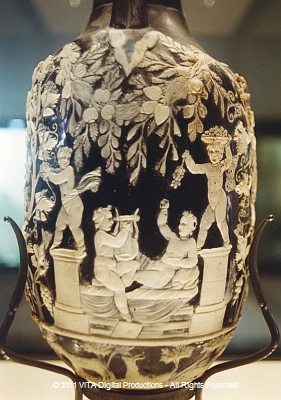
Here in the museum, photography, with the usual stipulations, is permitted and I begin videotaping with a vengeance. Using Steadicam, Jr. is amazing - the camera seems to float and glide simultaneously. I travel up and down stairs, through hallways, around corners, through doorways, forwards, backwards, it makes no difference - the camera remains as stable as if it were on an elaborate tripod and dolly system. I am using, in addition to Steadicam, Jr., a wide angle lens attachment which allows the capture of a greater scenic area by the camcorder. The only drawback to the Steadicam, Jr. system is that the operator has to hold the camcorder and Steadicam, Jr. apparatus with only one arm. I quickly discovered, after holding it for hours and days and weeks with my right arm, that it was amazing how much pain could result. Nevertheless, I feel strongly that the video I am getting justifies the pain I am enduring.
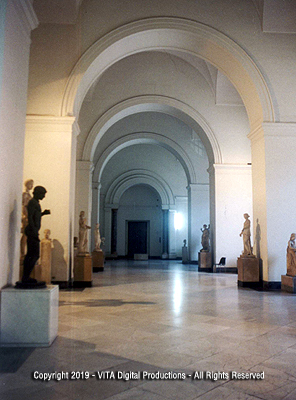
Two facts strike me about the Naples museum: first, that it contains an amazing and staggering collection of ancient works, not only from Pompeii, but also all over the region. And second, that it demonstrates clearly what we had been told about Italian bureaucracy. Our Conversational Italian teacher had informed us that about fifty percent of the people in Italy were employed by the government and once you had such a job, you had it for life. All over the museum, we encounter numerous bored guards doing nothing but sleeping or nodding or smoking.
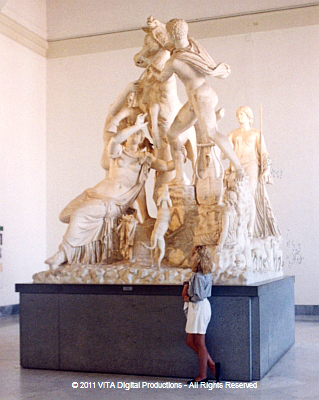
Everywhere we look we see statues, frescos, and artifacts that are familiar to us from photographs in textbooks, encyclopedias, art history books, etc. Certainly one of their most famous exhibits, the Farnese Bull, is an amazing grouping portraying an episode in Greek mythology. Its name comes from the Farnese Palace in Rome, where the sculpture was once kept. The Farnese Bull is a striking marble copy of a lost sculpture made in the 100's BC. Unknown Roman sculptors made the copy in the AD 200's and it was discovered during an excavation in Rome in the 1500's.
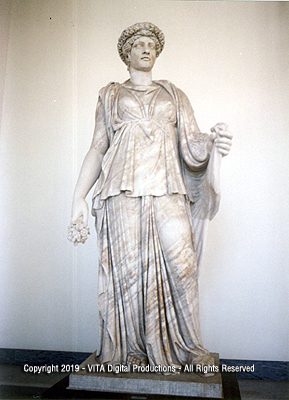
I shoot several hours of video in the museum before we have to leave at 7:30 PM. We take the Metro from the Piazza Cavona to Piazza Garibaldi, then the 8:15 PM train (il treno) back to Sorrento, an hour's trip. Back at our hotel, we enjoy a private picnic supper on our terrace.

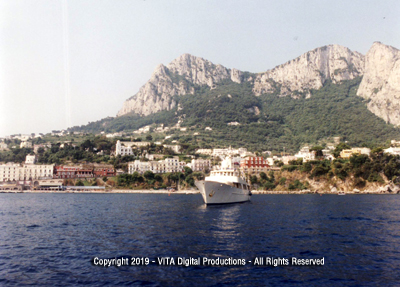
Day 15 - Monday - July 5, 1999 - Kathi to Capri and I return to Pompeii:
Today, Kathi joins Marcy and Jay (the newlyweds from Boston who also have the extension in Sorrento) and returns to Capri for the day while I set off alone for a return visit to Pompeii. After breakfast Kathi, Marcy and Jay walk down the hill to the Marina Grande and purchase hydrofoil tickets (13,000 Lire each way) and then enjoy a morning cappuccino at one of the umbrella bars as they wait for the boat.
After the boat trip over to Capri, they take the funicular back up to Capri Town and then spend a few pleasant hours window-shopping and exploring the winding high streets. Since this region is so well-known for its production of lemons, Kathi skips a traditional lunch in favor of a delicious lemon torte and, later, a fresh crushed limonata - so refreshing! They return to Sorrento on the 3:20 PM hydrofoil and then walk back up the hill to the hotel. Note: The last ferry from Capri leaves at 6:30 PM; thus, the day tourists leave so that the overnight island guests can better enjoy their very expensive hotels and restaurants in peace.
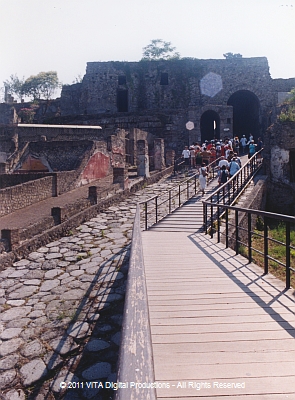
While Kathi was enjoying Capri, I set off to the train station and attempt to purchase one round trip ticket to Pompeii. What I get are three, one way tickets from Sorrento to Pompeii - there was a breakdown in communications -- or maybe my Italian isn't as good as I thought. Anyway, they don't cost very much so I just take them and leave without comment. I take my seat on the train and set out to Pompeii.
Once there, I purchase a ticket and enter the city through the Marina Piccolo gate. I have brought my tripod with me today instead of the Steadicam and begin videotaping. I take my time and attempt to get some carefully set up shots. I shoot in the Basilica, the Forum and some of the back streets. Walking toward the Amphitheater, I discover just how big Pompeii really is - it's huge and dusty. And more importantly, it lacks restrooms. The only restroom facilities are near the entrance and when you get to the Amphitheater you are over a mile from them. Well over a mile.
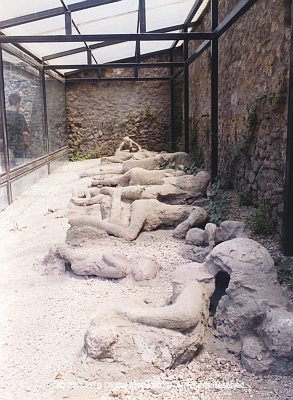
Using my map I search for and finally discover "The Garden of the Fugitives," the site where thirteen bodies (actually "casts") were discovered in the 1980's. This group of people (were they a family?) died together from poison gas and ash raining down on that fateful day in 79 AD. As usual, when their remains were discovered in the solidified ash, plaster was poured into the cavities. Once hardened and the ash removed, these thirteen melancholy casts revealed not only adults but also children.
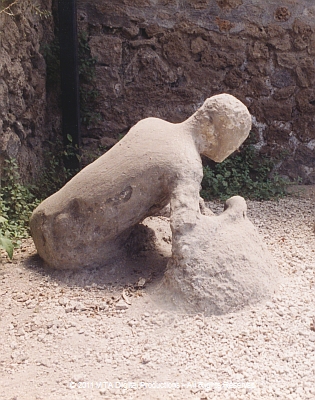
The most famous of all the casts discovered at Pompeii, the one used by the National Geographic Society in their magazine and TV documentary, is here in the "Garden." He is almost sitting upright, resting on one arm, looking straight ahead. It is a very strange position in which to die.
While I am photographing this somber scene, a man in his early 30's approaches, already engrossed in conversation with someone on his cell phone. He, preoccupied with business matters, continues to carry on his conversation as he stands and looks at the thirteen white casts before him, oblivious to their significance. Minutes later, his wife arrives and she too, has no idea what she is viewing. The businessman asks his wife, "Are these real bodies?" and she replies, "I guess so."
Well, I couldn't stand it any longer so I attempt to explain the import of the scene before us. When I finish explaining, the man thanks me.
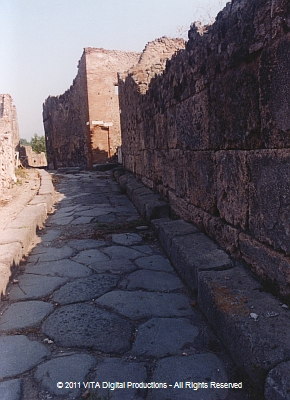
Pompeii is so big that one can go down a street and find himself completely alone. I continue to photograph for a few more minutes before leaving the city through the entrance. Stopping at a souvenir shop, I discover a videotape playing on a TV monitor, "A Virtual Tour of Pompeii" This program was a computer generated reconstruction of Pompeii at its height of power and glory. Homes and buildings portrayed in this program are new and fresh and the viewer seems to actually enter many of these homes and tour them. I inquire if a NTSC (US television standard) copy of this videotape is available and it is, so I purchase it.
Back on the train, I return to Sorrento using one of the extra "Sorrento to Pompeii" tickets I have. Luckily, no one asks for or examines my ticket.
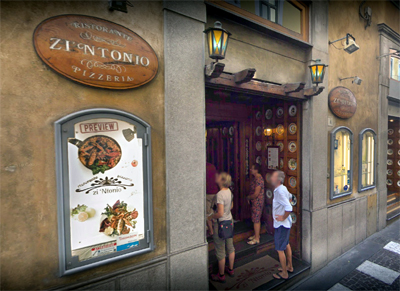
Returning to the hotel, I meet Kathi and we dress for dinner. Around 7:00 PM, we walk down to the village, walking all the way down the curved road to the Piccolo Marina. We watch the sun set at Peter's Beach, near the marina, and, after climbing back up the incredible hill back to the center of Sorrento, we went to Zi'ntonia for dinner.
Vincenzo had recommended this restaurant before leaving and said to specifically tell them he had sent us - we'd get better service. (Are you thinking what I'm thinking?)
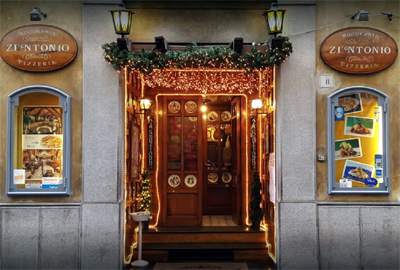
As we enter the restaurant, we meet Gloria and Elayne as they were leaving. Kathi and I order from the fixed price menu (21,000 Lire each) and enjoy the food and ambience very much.
The head waiter, Thomas, is attentive enough but, towards the end of our meal, I ask him about the photographs of a bearded Catholic priest which we had noticed everywhere we had been during the past week. Who was he and why did every place we went seem to have a photograph of him displayed?
At that point, Thomas took a seat at our table and I knew I had asked an important question.
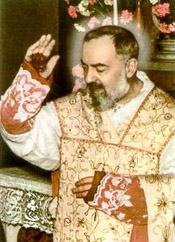
Thomas explained that he was called Padre Pio and he was a much-loved priest known for many miracles performed during his lifetime. Padre Pio was in the last stages of being canonized by the Catholic Church. As Thomas talked of Padre Pio and his life, we could feel the love and admiration he had for this Priest. Our fixe-price menu had specified a limited choice for dessert but after telling us about Padre Pio, our waiter brought us a special dessert not on the menu - dripping in rich chocolate and sinfully delicious!
This illustrates an extremely important but often overlooked aspect of travel which Kathi and I have discovered: to interact with and to ask questions of "locals," and in so doing, to gain a richer understanding and appreciation for their culture. It's also a great way to make new friends.
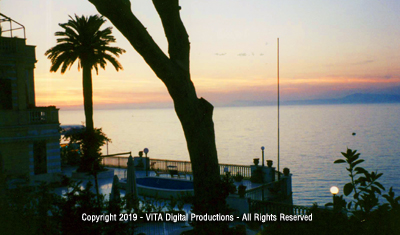
After a leisurely, hand-holding walk back up the hill to the hotel, we proceed out onto the main terrace to see the lights up on the mountains and those over the Bay of Naples. Tony, Marlu, and Karen swap stories with us about their adventures. Everyone seems to be having a wonderful time - all pursuing their own thing.
Bedtime at 11:00 PM - weary, but happy.

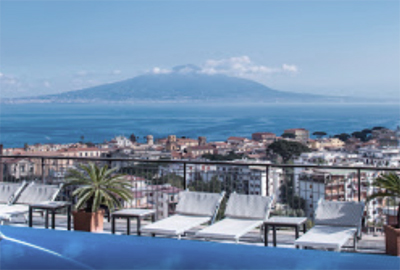
Day 16 - Tuesday - July 6, 1999 - Excursion to Herculaneum:
A leisurely morning as we begin our day with a late breakfast and a nice visit with fellow travelers, Marky and Noel, on the terrace of the hotel.
Once again walking down the hill to the train station, Kathi and I take the 11:37 AM train to Herculaneum (Ercolano), which is located on the outskirts of Naples. Because of its location, Kathi and I were once again on our guard against pickpockets and thieves. We were wearing rather plain clothes with no jewelry and had agreed to speak aloud very little while on the streets.
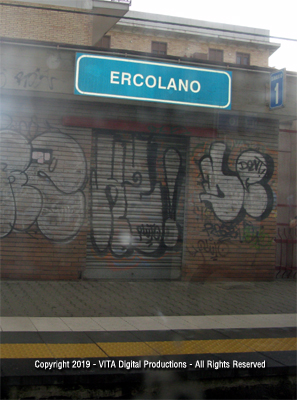
Once at Ercolano, we stop in the train station to use the restrooms which an elderly male attendant was in the process of cleaning. Something occurs here which I will always remember - two separate acts of kindness and caring.
Leaving the restroom, I take the camcorder out of the backpack to clean the lens. The old man who is cleaning the restroom points to my camcorder and, crossing both of his arms close in over his chest, makes me understand that I should hold on to it tightly. I nod my understanding and, opening my backpack, fold the Steadicam and camcorder and place it safely inside. Putting the backpack back on my back, Kathi and I thank the gentleman and leave the train station.
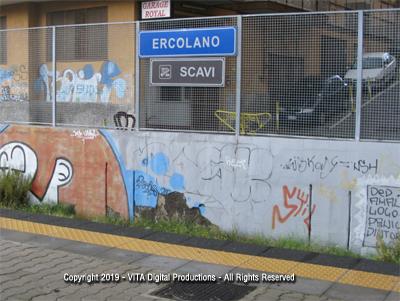
Once outside, we look for but are unable to find any signs for Herculaneum, the archeological site. Seeing an older lady who is also leaving the train station, I approach her and ask, "Scusi, dove Ercolano archeologico?" She first attempts to give me directions in Italian, but, sensing that I am unable to understand them, she motions for Kathi and me to accompany her down the hill - she will show us the way. She also cautions us regarding our belongings - we discovered later that the unemployment rate in and around Naples is over 30 per cent.
As we walk quickly down the hill we have a delightful talk with this lady - all in Italian which she speaks slowly for us - she tells us about her father, who was a teacher, and other things about her life. We are able to understand most of what she says - how beneficial our Conversational Italian course has turned out to be!
After walking with us for five blocks she stops, points to a specific window in a 4-story apartment building nearby, and tells us that is her apartment. She then points across the street to the entrance to Herculaneum and with that, she says, "Arrivaderchi!" Kathi and I say goodbye to the lady who has been so gracious and kind to us.
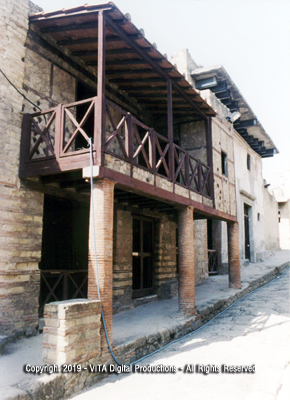
Herculaneum, unlike its sister city of Pompeii, is not tourist-infested. In fact, during the afternoon we are here, no more than 10 other people are on the site with us. Both cities were buried in the 79 AD eruption of Mount Vesuvius.
Herculaneum, the smaller of the two cities, was a summer resort and must have been spectacular. It is more interesting in many ways than Pompeii due to its less-crowded condition and overall accessibility. And, since this city was covered in a much deeper layer of ash and cinders, much more of its archeological treasures remain on site than do at Pompeii.
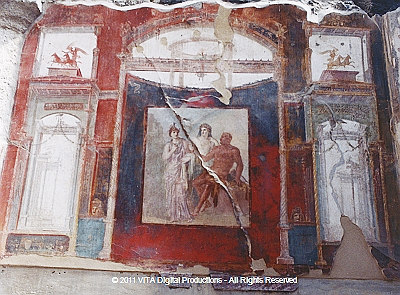
A visitor can still, near the end of the twentieth century, climb over ancient column pedestals and enter the rooms of 2000-year old homes: many of them still under original roofs! The mosaic tile floors are still there as well as many of the frescoes: somewhat faded and cracked, but glorious! The rich reds and blues, as well as the highly-lacquered blacks (like our gondola in Venice), tell tales of a highly-evolved lifestyle and gracious living.
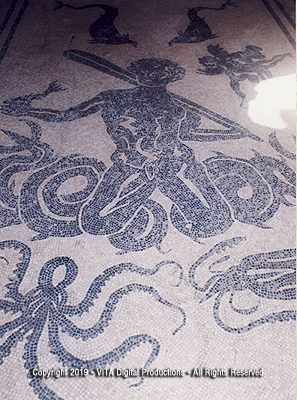
A mosaic in the Suburban Baths.
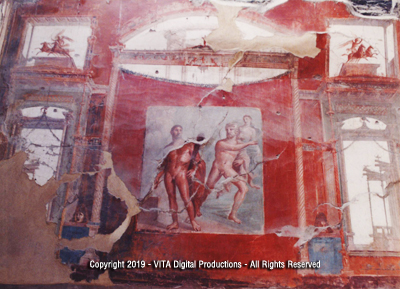
A fresco in the Hall of the Augustals, a temple of the imperial cult of Augustus.
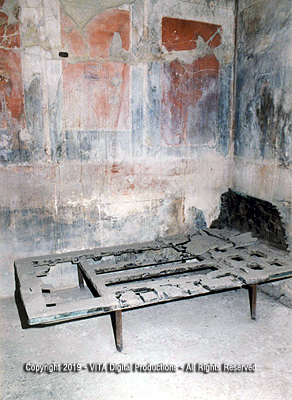
Unlike Pompeii, the pyroclastic material that covered Herculaneum carbonized and thereby preserved wood in objects such as roofs, beds and doors as well as other organic-based materials such as food.
A carbonized bed.
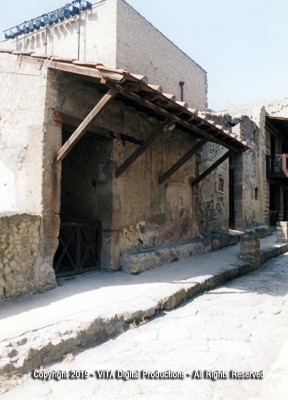
Cardo IV - a Commerical Street in Herculaneum.
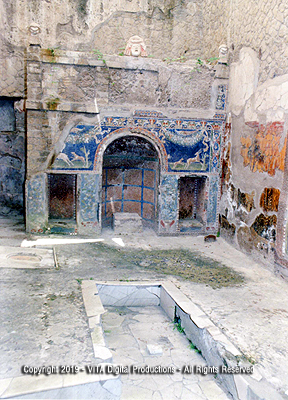
Although most of the residents had evacuated the city in advance of the eruption, the first well-preserved skeletons of some 400 people who perished near the seawall were discovered in 1980.
We had a wonderful day together in this magical place - wandering down streets and into houses, seldom encountering another person.
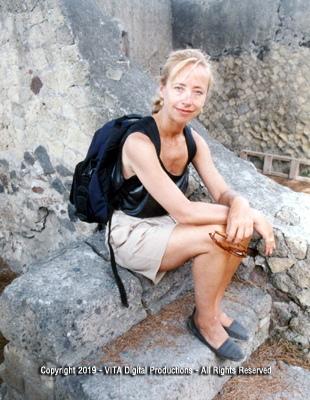
Hot and tired, we climbed the hill back up to the train station.
Kathi and I were apprehensive but, fortunately, nothing untoward happened to us and we returned to the hotel around 6:45 PM for dinner in the room and nice long showers.

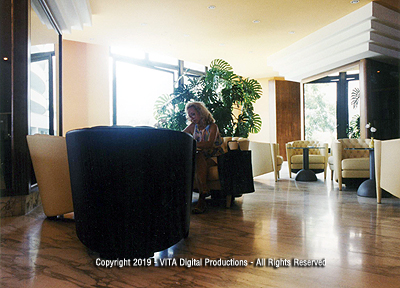
Day 17 - Wednesday - July 7, 1999 - At the hotel in Sorrento:
This is our last day on the Amalfi coast and we are both feeling our age! I am dividing my time between photography around the hotel grounds and relaxing at the pool, and Kathi is sitting and writing in her diary in the hotel's ballroom.
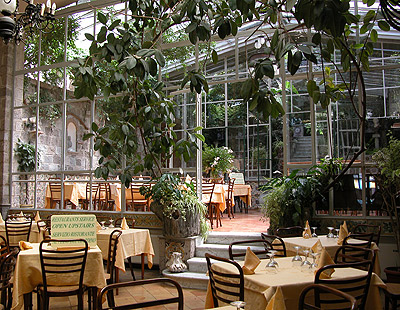
After a very laid-back day, we dress and walk down the hill to have a private farewell dinner in Sorrento. Upon Noel's recommendation, we dine at O'Parrucchiano, on the Corso Italia, 71.
Our table is outside under a huge grape arbor with lemon trees and tropical plants almost surrounding us. It is a beautiful place with good food and pleasant service. Sixteen years later, Kathi and I would have the pleasure of taking my daughter to the same restaurant.
After dinner, we walk back up the hill to our hotel and have a last dance on the incredible terrace overlooking the Bay of Naples.

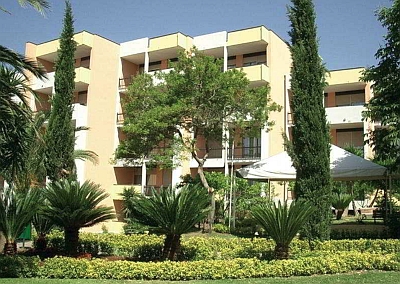
Day 18 - Thursday - July 8, 1999 - Sorrento to Rome:
Up and to breakfast for the last time in the Sorrento Palace's dining room. At 7:30 AM our bus leaves with the extension group from our tour: Karen and Frank, Marcy and Jay, Markie and Noel, Tony and Marlu, and their children Jessica and Justin, Elayne and Gloria, and Kathi and me. After about four hours of travel and the customary restroom and cappuccino stop, we arrive in Rome shortly before noon.
We check into the Parco Tirreno on the Via Aurelia on the Northeast outskirts of Rome - not far from our first hotel, the Jolly Midas. Our room is a suite with a small balcony, but in a very ordinary hotel. We have experienced many highs and a few lows on this trip, and this hotel would definitely be on the lower end.
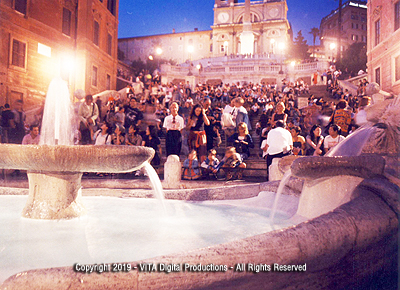
Kathi and I, as soon as possible, walk about 5 blocks to the bus stop and take the bus to the Flaminia subway station, and from the subway station we ride to the next stop, the Piazza di Spagna. Exiting the station we walk around the corner and we are at the foot of the famous Spanish Steps.
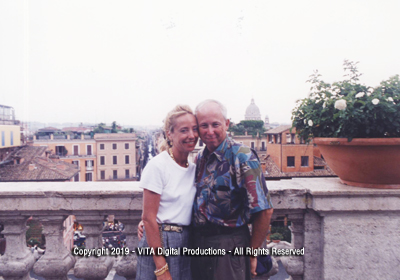
Wandering around for a while, Kathi and I spot several Globus friends at the top of the Spanish Steps and we ask them to take our photo.
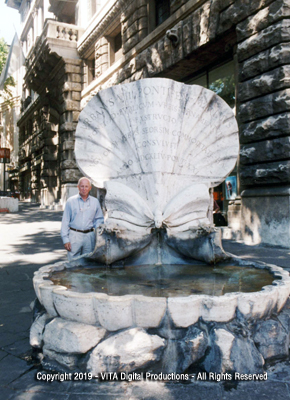
Two of our friends join Kathi and me and explore the city, stopping for some cappuccino in a stand-up bar near the Termini Station. We walk along the Via Veneto and later find that our tastebuds are crying out for some non-Italian food. We stumble upon a Chinese restaurant, and entering, we enjoy chicken, pork, shrimp, calamari, and sweet and sour soup.
Fountain of the Bees by Gianlorenzo Bernini, Via Veneto.
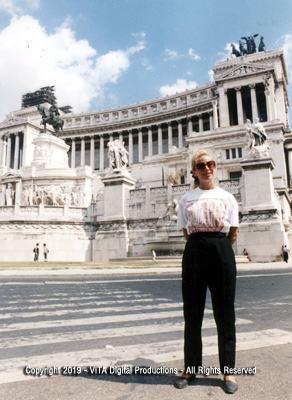
Tomorrow the last of our Globus group leaves for the US. Only Kathi and I stay on for three more days in Rome - alone, all by ourselves.
Marky and Noel will be off to Russia next month and Gloria and Elayne are going to Siena for a few days and then on to France and England. What an amazing group of travelers!
Kathi and I return to our hotel room, first stopping in the gift shop to examine their wares. Then to sleep.

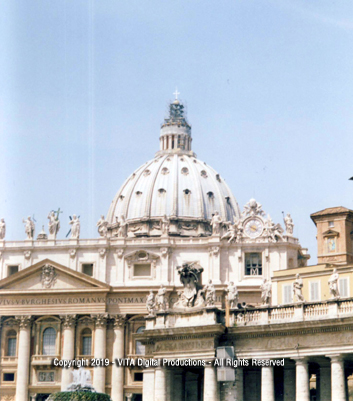
Day 19 - Friday - July 9, 1999 - The Vatican Museums in Rome:
Up at 6:30 AM and to breakfast in the hotel's dining room. Of all the hotels we've stayed, this hotel has the absolute worst breakfast. There is a pink juice that is unidentifiable and unpalatable along with something that looks like scrambled eggs but doesn't in any way taste like them, with bacon that is so raw as to be inedible. I opt for a hard roll and some pastries.
Kathi and I are both anxious to get back to the city so, after breakfast, we walk the five blocks to the bus stop to catch a bus to the Vatican. We will not have to transfer to the subway today, since the Vatican is on this side of the Tiber.
We stop at a Tobacconist to purchase a book of ten bus tickets. Each ticket is 1,500 Lire and is good on any bus for 75 minutes and includes one Subway transfer. Unfortunately for the Italian government, there is no one checking to see if you punch in with your ticket as you enter the rear of the bus, so most, if not all, riders don't pay.
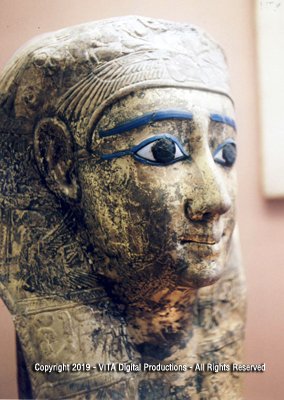
Once at the Vatican Museums, Kathi and I wandered through the thirteen separate museums for hours. I am running low on videotape - how would I know that 22 hours of videotape which I brought with me would not be enough?
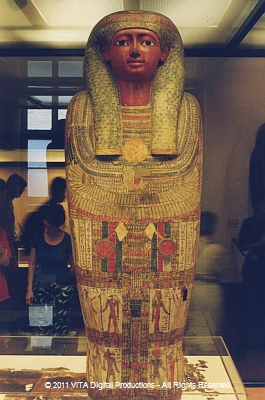
The first museum we enter is the world famous Egyptian Museum which contains many mummy cases and artifacts included in Egyptian tombs, Ushabti, and funerary jewelry. It contains marvelous artifacts to see.
Later, Kathi and I stop in the beautiful Sistine Chapel to admire Michelangelo's recently restored 34 ceiling panels - but no photography is permitted. When Kathi first saw the ceiling on her first trip to Rome in the early 1970's, it was dark and lusterless; but now it is bright and vivid. Her favorite panel is the Libyan Sibyl. The colors are so lifelike and the people depicted appear 3-dimensional. It is a moving experience. Michelangelo was commissioned to paint the Sistine Chapel ceiling while only in his 20's (1508-1512).
He returned in his 60's to paint The Last Judgment: Saints on the right hand of God, sinners falling into the pits of Hell on His left hand, and Michelangelo's self-portrait on a stretched, elongated skin hanging midway between the two. Interestingly enough, one of the sinners bears the face of a Cardinal whom the artist detested. A snake has his fanged mouth over the sinner's genitalia, and the Cardinal's agonized expression indicates that he knows his fate!
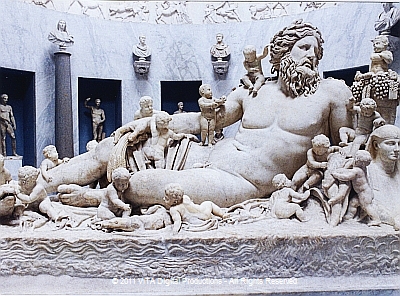
Leaving the Sistine Chapel, Kathi and I walk through other museums and finally arrive in the Pio-Clementine Museum - one of the highlights of the day. Here we see the famous sculpture, "The Nile," dating from the 2nd to 3rd century AD.
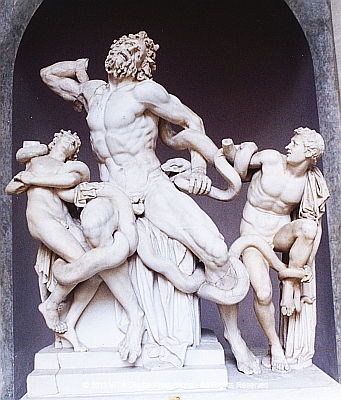
Kathi has been telling me about the famous "Laocoon" grouping for some time and when I finally see it I am certainly not disappointed.
The sculpture grouping was executed in the early part of the 1st century AD by three Rhodes sculptors. Pliny the Elder (killed in Pompeii when Vesuvius erupted in 79 AD) declared it to be the most perfect sculpture in the world. Apparently, it was - because Michelangelo is said to have been really inspired by it 14 centuries later.
The sculpture tells the story of a priest who, upon seeing The Trojan Horse, suspected a plot and shot arrows into the horse. This so angered Athena that she sent a serpent up from the sea to kill Laocoon and his sons. It is indeed a powerful work of art.
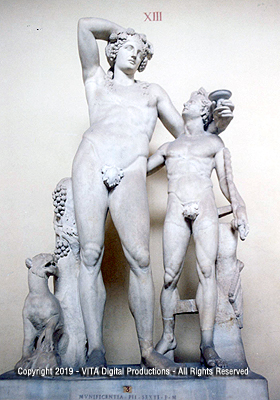
In the same courtyard as the "Laocoon" is another statue which I found interesting because of its added fig leaves. Many of the statues still have fig leaves on them, many never did, and a few had at some point in the past had fig leaves placed on them but they were later removed and one can still see the discoloration where the fig leaf had been. Fig leaves were added by some of the more modest popes, and taken off by later popes.
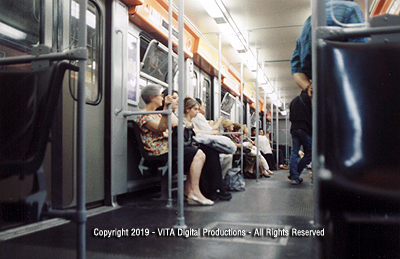
After leaving the museums, we walk across the street to a coffee shop and Kathi has a cappuccino and then we return to the hotel to drop off the backpack with the camcorder and Steadicam, Jr. I had run out of videotape and there was no use in carrying the heavy backpack if I could not use the camcorder.
We take a bus back to Flaminia, and ride the Subway back to Piazza di Spagna. Rome has a limited Subway system because every where they dig, they find thousands artifacts and other archeological treasures.
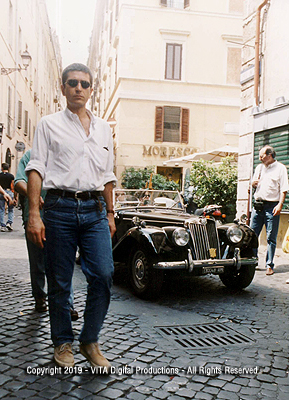
We browse and stroll along the Via del Babuino, an incredibly exclusive shopping district. Kathi looks for and finds the shop called Etro (one of the places mentioned in the book, Born to Shop) and purchases for me a pair of French knot silk cufflinks.
I notice, but Kathi does not, a small but important detail concerning our entry into this exclusive store. Kathi and I are dressed in some rather comfortable but plain tourist clothes - I have my camera vest on and am in shorts, Kathi also in shorts. When we arrive at Etro, a man dressed very smartly walks to the door in front of us and I hear the distinct "buzz" that occurs when an electric door lock is released. Kathi and I walk right in a few steps behind the gentleman who has been admitted.
After leaving the store, I point out to Kathi that this store, like many other exclusive stores, has their front door locked and only unlocks it for certain patrons, e.g., those who "look" like they belong there - and if the gentleman in front of us - for whom they unlocked the door - hadn't been there, it is debatable whether or not they would have unlocked the door for the two of us, dressed as we were that day.
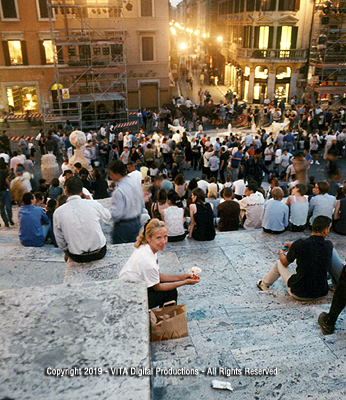
We next meander along the Via del Corso before reaching the most elegant McDonald's we've ever encountered. This McDonald's is rather famous both for its decor and for being just a block away from the Spanish Steps. It has marble floors, wonderful greenery and statuary tucked away in marble alcoves, clean American-style restrooms, and, more importantly for Kathi at least, a gelato/cappuccino bar. Kathi could not believe it. It certainly is the largest McDonald's I've ever seen with around 15 cashier/serving lines - all with lines about 10 deep. But be careful, unless you specifically ask for it, they will serve you mayonnaise with your French fries instead of catsup.
Kathi and I order "take away" as it is called in Italy and walk the short distance to the Spanish Steps where we enjoy our dinner at sunset watching the view, other people and holding hands. Incredible! (Note: Eating while on the Spanish Steps is no longer permitted.)
Around 9:30 PM we return to the subway station, ride one stop to the Flaminia station, board our bus and ride back to the bus stop, and then walk back to the hotel, arriving around 10:00 PM.

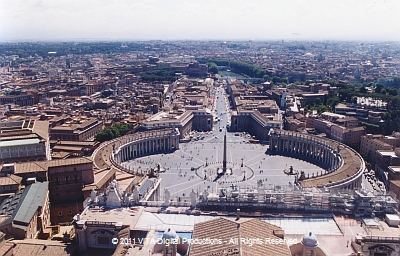
Day 20 - Saturday - July 10, 1999 - St. Peter's in Rome:
Up early today and onto the bus to San Pietro, Vaticano. We're becoming old hands at public transportation. Once at St. Peter's, we take the elevator inside the Vatican to its top floor, and then climb the 320 steps to the highest gallery on the outside of the Basilica's dome. We stand as close as we can to the giant bells just as they begin to chime 10:00 AM.
A beautiful view - St. Peter's Square and the Tiber River below us. While at the top, we engage in an interesting conversation with a young schoolboy on holiday from Poland. Afterwards, we tour the crypt and view the tomb of St. Peter. We return upstairs and stand on the large round purple stone where Charlemagne was crowned in 800 AD.
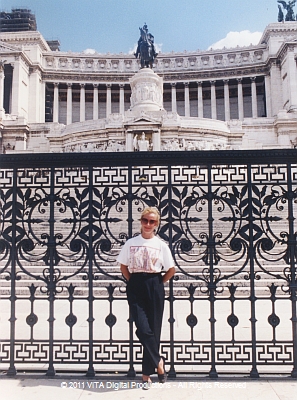
Leaving St. Peter's, Kathi, of course, must stop for a gelato - two scoops, one chocolate and one mint. Then a long walk along the Tiber River under shade trees lining the street. After a while, we stop for pasta and shrimp salad at a tiny sidewalk café and, while there, enjoy the violin music of a street musician. Unfortunately, we discover that the Capitoline Museums are closed now in preparation for Jubilee 2000.
We continue our walk, stopping at the Vittorio Emmanuele Monument for photos of Kathi - it was the first famous monument she discovered on her first trip to Rome. The "wedding cake" structure, also known as Il Vittoriano, was built between 1885 and 1925 to honor Victor Emmanuel II of Savoy, the first king of unified Italy. Finally, we reach our objective, the Via Nazionale where Kathi lived in 1972.
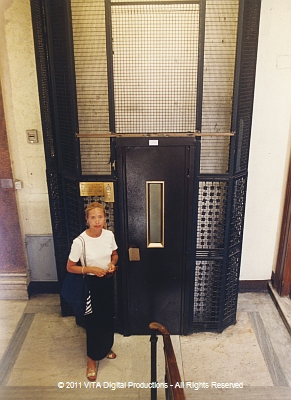
Walking along the Via Nazionale, Kathi shows me the building which (she thinks) had housed the Pensione Max - her first residence in the Eternal City back in 1972.
She narrows it down to two possibilities. The one most likely, judging by the downstairs foyer and the position of the cage elevator, has now been refurbished: quite a transformation. I urge Kathi to go upstairs with me and investigate - she hesitates at first, but relents. Once in the office, we explain our quest to a nice young lady in charge of the desk who graciously shows us her accommodations.
It is very pretty, so we take a brochure (maybe we'll return and stay here sometime in the future.)
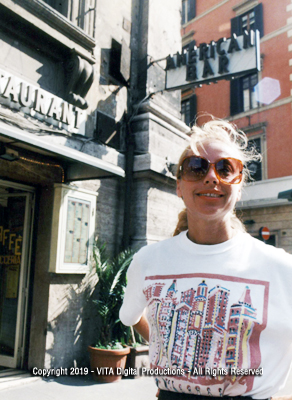
We next visit the American Bar (where Kathi used to literally count out Italian coins for American coffee - alas at that time she had no appreciation for cappuccino.) The new owners have expanded their establishment, but it retains its original cozy character.
On down the street to St. Paul's Within the Walls, the American Episcopal Church where Kathi had worshipped while working in Rome as an au pair.
All during this afternoon, Kathi has experienced the sense of "coming home." She remembers all of the feelings of excitement and adventure, and we both delight in the newfound joy of traveling the world together.
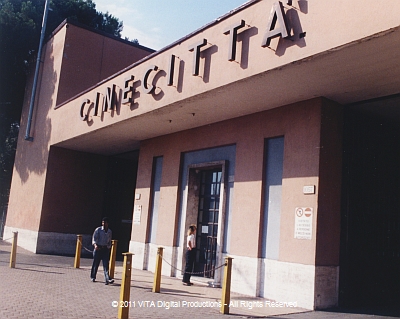
In the late afternoon, my curiosity draws me to take the subway all the way to the end of the line to visit Cinecitta, the famous Italian movie studio where Elizabeth Taylor filmed her spectacular procession into Rome in "Cleopatra." Fellini filmed "La Dolce Vita" here, as did Charleton Heston his "Ben Hur." Kathi is gracious enough to walk around the entire lot as I take photographs.
We discover that "tours" are given on Saturday evenings at 7:00 PM and I certainly wanted to take one. But after waiting and waiting and waiting, and reading the brochure, I finally reach the conclusion that it is all probably a "tourist trap" and we wouldn't actually see any of the sound stages or backlot so we left Cinecitta and returned to the subway.
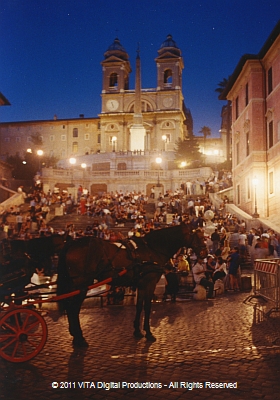
Arriving at the Spanish Steps subway stop, we once more return to the nearby McDonald's and purchase "take away" and enjoy another sunset and alfresco dinner on the Spanish Steps.
Wonderful, one could easily get used to this.
Back at our hotel around 10:00 PM.

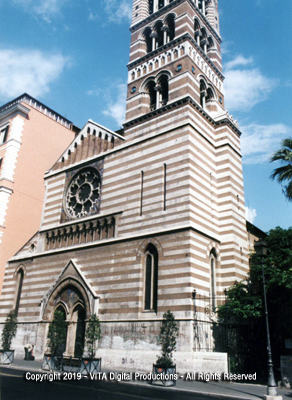
Day 21 - Sunday - July 11, 1999 - To church in Rome:
Due to practical considerations (mainly dress and too much luggage already), we opt not to go to the Via Portuense for the mercato delle pulci (flea market) at Porta Portese. Kathi went there when she was living in Rome in 1972 and says that it was something to behold and we had wanted to visit it this morning. However, we slept in this morning and then left for church service.
We're both dressed in church clothes today and therefore look nicer (and wealthier) than we normally do. We take the bus from the bus stop to the Flaminia station, then the subway to the Termini station which is near the Via Nazionale and a short walk down the street to St. Paul's Within the Walls.
How appropriate it is for Kathi to return to this church, the church she attended 27 years ago while living in Rome.
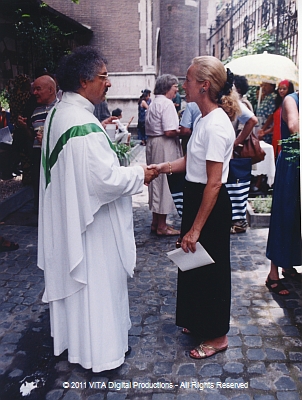
For me, the service is remarkably familiar - almost the same service as ours back home, except for one factor: the service is sung by the Priest. The congregation is not large, consisting of no more than 100 souls. When the service is over, I take some photos inside the church and then we move outside for a welcome gathering and refreshments.
Kathi has a chance to meet the current Rector and tells him of her return to St. Paul's. We also meet a lady from Altadena, California, where our friend Jan lives. It is a small world.
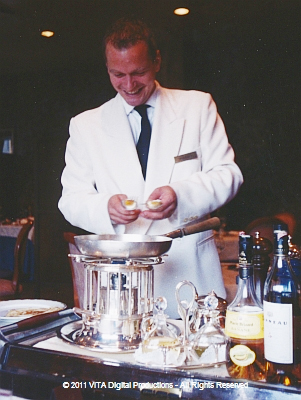
Leaving St. Paul's, Kathi and I walk down the Via Nazionale finally arriving at the Bernini Bristol, a five star hotel in the Piazza Bernini. Kathi, while living in Rome, had always had a desire to dine at this hotel's famous restaurant and today, she will get her wish. Entering the restaurant, we discover that we are the only patrons - they usually serve a rather large number of guests breakfast but very few dine here for lunch. So today, we are and will be their only guests.
Our head waiter is a handsome, blue-eyed, Paul Newman look-a-like who speaks very good English. Wine is served automatically and I attempt to drink it but, alas, I'm not a wine connoisseur. Our waiter, dressed in an immaculate white dinner jacket, prepares our meal on a cart before us and I am amazed that throughout the entire luncheon, he never gets a single stain on his dinner jacket.
As he is preparing our entree, he tells us of his background.
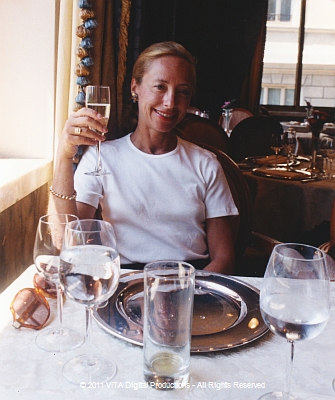
He was born in Italy, mother was Swedish and father, Italian. He has worked for many years as Head Waiter on cruise ships but his wife wasn't happy with him being away from home for such long periods of time. He wants to come to the United States and open a restaurant but is unable to get a visa.
We are impressed by our waiter's demeanor, his sense of humor, and his intelligence and tell him that, with his talents and drive, he could easily become very successful in the US.
For dessert, we have crepes.
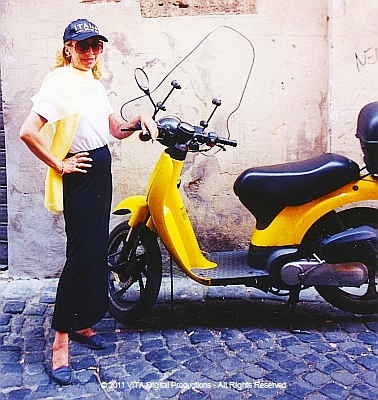
Leaving the Bernini Bristol, Kathi and I first walk down the Via del Corso and then just wander down small streets and alleyways, admiring the wonderful Roman buildings. Kathi had purchased a few days earlier a beautiful yellow silk scarf and she decides she wants to find a matching motor scooter for a souvenir photo.
So we look and look and look without any luck. With the thousands of motor scooters in Rome, one would think that there would be at least one yellow scooter parked somewhere. Finally, we discover one parked in a back alley and, with Kathi posing beside it, I quickly take her photo.
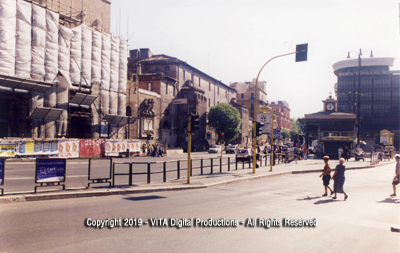
We're both tired and we have a lot of packing to do before flying home tomorrow morning, so with many regrets, we decide to return to our hotel. We walk to the nearest major street hoping to find a bus stop sign nearby. And ahead, about a block away, we do in fact see one.
Approaching the sign, we discover that only bus "64" stops here - the infamous "Bus 64" of which most of my travel guides had warned. We look at each other and, since we're both too tired to walk any further, and we're both wearing money belts under our clothes and nothing of value is in our pockets, our choice is simple.
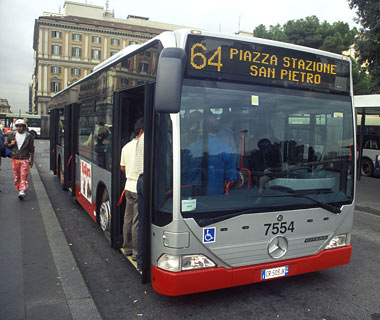
And besides, what are the chances that someone will actually try to pick my pocket anyway?
Bus 64 arrives in a few minutes and we enter the front of the bus behind a couple with a baby carriage. Upon entering and before the bus has actually started moving, the driver says something in Italian which we interpret as "Move as far back as possible," and so I squeeze a little closer to the other passengers who are also standing in the front third of the bus. The driver repeats his instruction, this time a little louder - so again I squeeze a little closer to the other passengers and the bus begins to move.
As the bus picks up speed the man standing next to me begins to "bump" into me sporatically and I immediately begin to feel something like a butterfly's wings "flapping" in my right trouser pocket.
Can you imagine my reaction? I mean, come on..... I had read the warnings about "Bus 64" and here, within mere seconds of getting on Bus 64, someone is trying to pick my pocket. And he's not very good at it!
More indignant than surprised, I quickly turn to face the man next to me and state, quite loudly, "There's nothing for you in there - nothing at all!" He looks surprised and I turn to Kathi, who is squeezed between several other passengers and is five or six feet away and state, again quite loudly, "He had his hand in my pocket, right down in my pocket!"
I turn back to my new "friend" and he is shrugging his shoulders in a sort of "I don't know what you're talking about" manner and I say, "Oh don't give me that, you know what you were doing, you were trying to pick my pocket!" Everyone on the bus is now looking at me but a mixture of adrenaline and indignation is sweeping over me and I continue talking, this time addressing Kathi loudly again, "He was trying to pick my pocket - he had his hand right down my pocket."
At this point, the bus stops and my new "friend" exits quickly. Kathi pushes her way next to me and we continue to discuss the "incident" until we arrive at our stop - the Termini subway station. We exit the bus and walk to the subway station and I feel elated.
In many ways this was the "perfect" ending to our three weeks in Italy - someone attempted to pick my pocket and I caught him in the act! Tourists 1 - Pickpockets 0.
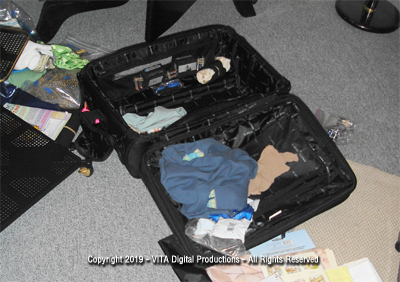
Back at our hotel, we begin to pack and discover that we have accumulated too much "stuff" to fit into our luggage and will have to discard many things - but what? The choice is difficult but has to be made. One of the largest and heaviest items I had brought with me, the tripod for the camcorder, was used only once - at Pompeii - and I had to ask myself had it been worth it? Probably not. I had also brought 11 video cassettes, 6 camcorder batteries and a charger for them along with 54 rolls of 35 mm color film for my still camera, all absolute necessities in my opinion.
We have arranged with the front desk for a car to take us to the airport tomorrow morning to make our flight out of Rome. Finally, with bags packed to almost bursting, we turn in for our last night in Italy.

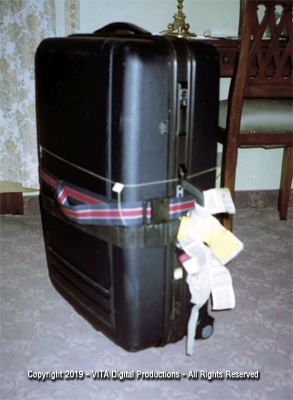
Day 22 - Monday - July 12, 1999 - Rome to NYC to Cincinnati to Raleigh to Home:
Up and down to "breakfast" in the dining room. Then back up to our rooms to wrestle our baggage down to the lobby. Since the tour ended almost a week ago, we've had to become our own porters and be responsible for our luggage ourselves. We don't have to wait long for our driver, who arrives in a nice new Lincoln. We have been told by the desk that the fee will be 40,000 Lire for the 20 minute drive to the airport and when we arrive there, I tip our driver an additional 10,000 Lire. I ask to be dropped off at the Delta terminal and he stops at a Lufthansa terminal and tells us that Delta is just a short distance beyond - but it isn't. We have to walk, dragging our luggage behind us, to the far, far end of the terminal to find Delta's check in desk.
This is the part of a long journey which I dislike the most. The lines one has to go through, the check points, the unnecessary waiting, and the worry. Will something unexpected happen to keep us from catching our flight - some small detail that will screw up things and set off a domino-like series of events that will prevent us from getting home? Example: After our luggage is taken from us and sent to be x-rayed, a Delta representative asks us if we have any battery operated devices in our luggage and I respond, "Yes, I have an alarm clock in my suitcase." The fact that it still has the batteries in the clock is the problem. When x-rayed, a clock with batteries inside could possibly look like the makings of a bomb to security personnel and my luggage could either be torn open or cause me to be held for questioning, the Delta agent tells us. So for the next hour or so I worry about what happens if my name is called or my luggage is torn open and 54 rolls of film and 11 video cassettes are lost in the process. Fortunately, none of this happens and we finally board our plane and take our seats. Our seats, by the way, are wonderful. Anne, Kathi's travel agent for many years, has taken the trouble to get us excellent seats, always next to a window and an aisle. And when you have to endure a seven and a half hour flight, good seats are a must.
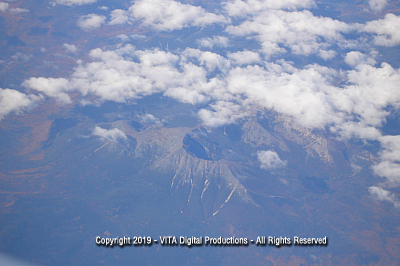
Sitting across the aisle from me (Kathi has the window seat) is an Italian gentleman with whom I have a short conversation. He tells me that the Vatican is in reality, a large multi-national corporation with business concerns in various countries all over the world. He goes on to state that the Vatican even owns a factory that manufactures condoms! He assures me that this is true. I tell him a story which Vincenzo related to us about the female Pope and he confirms that also. Amazing.
The flight westward takes longer than our flight coming eastward to Italy and this fact seems counterintuitive. Since the Earth rotates from west to east, intuition tells me that would effectively make us fly faster but it doesn't. In fact, it is the jet stream and head winds which actually slow down the plane's forward progress and make the flight longer when traveling westward and shorter when flying eastward.
Our flight first takes us over the island of Corsica, across the French Riviera and France. Lunch is served and later dinner. This journey is more complex than the one we made three weeks ago. Kathi and I arrive at JFK, then take a connecting flight to Cincinnati, and from Cincinnati we fly to Raleigh where my daughter is scheduled to pick us up.
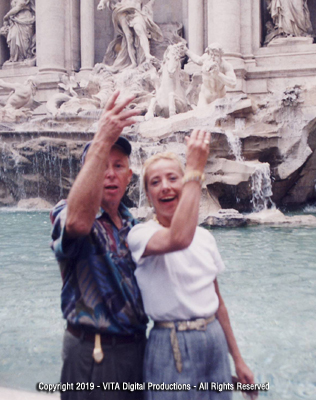
All in all, this has been an amazing trip. We've visited many different areas of Italy, met many kind and interesting Italians, made new friends, and learned a great deal about the inhabitants (both past and present), the history, and culture of a magnificent country.
As is tradition, Kathi and I threw coins in the Trevi Fountain, in the hopes that we would return to Rome...
...and we have, many times.

Copyright 2019 by VITA Digital Productions - All Rights Reserved
Contact us for permission to use this or any part of this article.
Copyright © 2019 VITA Digital Productions - All Rights Reserved
Template by OS Templates